

Please note: Not all links are referral or affiliate links, however, some are.
Firearms | Preparedness Gear | Supplies | Training & Reference
HC Collection in France produces these kits for .32 Rimfire, .32 Rimfire Long, .38 Rimfire, and .41 Rimfire, as well as several pinfire calibers.
The .32 Rimfire kit contains cartridge cases, bullets, swaging tools and dies, and comes in a wooden case. Because it shipped from overseas, it did not contain primers, but those are readily available here.
As you can see from the photos, the cases are machined with an offset pocket for a .22 blank, that serves as the primer. The cases have to be properly indexed for a revolver, and manually loaded for a rifle even if it is a repeater.
The instructions are clear, and the process is simple. Swage the case to size if it isn't already. Insert case in the die base, place the bullet, and then tap the die with a mallet to seat the bullet. The die depth is setable and adjustable with a wrench.
If the bullet is oversized for your firearm's bore, the die can be inverted and the bullet tapped through to reduce its diameter .1mm (about .0039). The provided bullets measured .317, which is very close to factory spec for .32 Rimfire.
The seated case in the die is then inverted, black powder added, and the blank pressed carefully in place with a wooden block--this is the necessary sequence since the rim is sensitive to ignition and should not be placed in the hard metal of the die base. I had no issues doing this, but do it over a wooden surface, and press carefully just in case. The die is sturdy enough to contain a discharge, but you don't want a hard metal surface underneath.
Note that this requires a standard .22 blank. DO NOT use a .22 or 6mm nailgun powerload. Also note to fill the case fully with the correct grain powder (FFFg should be correct, but check a loading table and compare to your weapon, keeping in mind that antiques should be professionally inspected before use, if you are unsure of the condition). A partially filled case can lead to chamber explosions. If in doubt, consult a reloading text on fillers to match the propellant.
The kit contains depriming tools and a powder ladle.
This isn't an inexpensive investment, but you can order extra cases (I got a total of 36), and they should last multiple reloads, since the pressure is low. This makes obsolete rimfire firearms viable and functional again.
I'll add to this review after I can gauge shooting accuracy.
Note that some banks simply will not process an international charge or transfer to France. Both my bank and PayPal card declined. Remitly doesn't serve France. Ironically, Xoom, managed by PayPal, did.
Shipping took about two weeks.
This is a pretty basic review. Containers are a necessary accessory for firearms, and hard cases are required for flying. MTM's cases are reasonably priced, sturdy, have two locking points for airline travel, and come in several sizes.
My daughter received the model 805-27, which fits most standard frame autos and 4" revolvers. New, and just coming available now, this one is in shocking pink. It doesn't make it a better case, but it does make it stand out.
We tried several drop tests, and it worked fine with several guns. No damage to the case being dropped on a concrete floor from bench height.

We're going to need to her a bigger version for her .45 Long Colt and her .44 Magnum.
MSRP is $7.77. And if you don't like pink, they have basic black. It's worth getting one for every handgun.
Traditions Training Cartridges are weighted and built like real cartridges. They include a rubber insert to function as snap caps. Unlike most aluminum snap caps, however, they are heavy and strong enough to properly cycle, without becoming damaged.
I recently tested these in 12 gauge, .223 rifle and .45 ACP.
The .45 ACP pack contained 5 cartridges with 6 rubber inserts. They were "loaded" with 230 gr ball projectiles, and apart from their black coating, were almost indistinguishable from live ammo. I cycled these through an Auto Ordnance 1911 clone, through a dozen different magazines with no problems with the cartridges. In fact, they helped me identify two problematic magazines. They fed flawlessly. The hammer drop felt noticeably different due to the rubber primer insert, but there were no issues with the action. They ejected very positively, just like real cartridges.
I tested the pair of 12 gauge cartridges (two in the pack, inserts already in place) in both a side by side ERA coach gun and a Remington 870 riot gun. They held up well to the mechanical ejection, and loaded perfectly.
The two pack of .223 were tested in an M4 clone. Again, they cycled just like real ammo. I randomly loaded both into a magazine of live ammo to practice stoppage drills. There was no detectable difference in the load part of the cycle, and upon the hammer dropping, they extracted exactly as a dud round should.
These are a professionally made and tough test and training tool I recommend acquiring.
They are available in gauges/calibers of 10 semiauto pistol, 7 revolver, 5 shotgun and an incredible 42 rifle calibers, including most common hunting calibers and several military surplus calibers.
Manufacturer's suggested retail prices range from $9.98 for a dozen .22 long rifle caliber, to $15.98 for a single .50 BMG (which I very strongly recommend as part of your kit, given the power involved in these rifles).
These are so realistic, I also strongly recommend extra attention to safety. Do not keep them near your live ammo when performing function tests, and inspect carefully before loading. Always have the weapon pointed in a safe direction, and a backstop.
NOTE: I was furnished a pack each of .223, 12 gauge and .45 ACP free for evaluation.
I like the AK platform, but I've never liked the base stock. I'm too tall, and the shape of it means I can't get my head low enough for a good sight picture, so I have to scrunch and contort to shoot.
ATI sent me their Strikeforce Stock Package to try. I've heard criticism of their products over the years, but, while I've made some of my own regarding functional details, I've never had a problem with their workmanship or reliability.

Darkened areas show where the stock package fits.
The instructions are clear, and you should pay attention to them. The lower handguard, for example, goes on slightly differently from the factory guard. They're easy enough to follow, and an allen wrench, Phillips and Torx screwdrivers are all that are needed for installation.
The buttstock assembly bolted right in place. Due to variances in manufacture, you may need to shim the receiver tang slightly. The stock is made of DuPont® Extreme Temperature Glass Reinforced Polymer, and feels solid. The castle nut is steel, not cheap aluminum. There is a locking tang to prevent the tube from rotating loose.
With the 6 position stock collapsed, it has the same length of pull as the factory AK stock, but, I was able to get a much more comfortable cheekweld and stance. Two clicks out was a perfect, comfortable fit, leaving four more clicks for people even taller than me. (I have 1.5" extensions on my AR15A2 stocks, for reference.) There is a cheek rest with stick on rubber padding, but I didn't need it. The cheek rest attaches with four screws. The AK isn't a hard recoiling gun, but it can be a bit brisk with the metal buttplate and mount angle. The recoil pad is just thick enough to take out any bite. The rubber material is made by 3M.
The grip is large and comfortable. The backstrap is cushioned, and the finger grooves felt right. My finger pad dropped exactly onto the trigger.
There are rail sections for the upper and lower handguards, that install with screws. If you decide not to install them, there are covers for the slots, that insert easily, remain in place, but remove from inside without difficulty.
Once set up, the rifle was easy, almost instinctive to handle and mount, balanced better and shot great. Furniture can't directly improve accuracy, but operator comfort and handling certainly does.
Criticisms: The lower handguard was very tough to get in place. I've seen this before with ATI products, though I don't know if there's a fix. Snug is good, and increases strength and reliability. Just be advised you may have to work at it to get it in place.
The grip was comfortable for me, but may be overly large for some small shooters. I'd also like to see the internal space exploited for storage.
The stock assembly should have a somewhat heavier screw, in my opinion. The single 8-32 seems a bit light. A 12-24 at least would be my recommendation, or a 6mmX1mm.
If I were to offer one improvement, that empty buffer tube should have a plug or screw thread at the rear, so it can be used for storage. It's right there, waiting.
If you like the AK, but are a taller shooter, this may be exactly the accessory kit for you. It looked a bit odd at first, but I'm quickly getting used to it, and plan to leave it on one of my AKs for the future.
The kit retails at $144.99, or, if you prefer just the stock, MSRP is $79.99, on par with most 6 position stocks. Both are available discounted at several outlets.
ATI Stocks are made in the USA.
DISCLAIMER: ATI furnished me the stock set through a promotional firm for test and evaluation. It is understood that I keep this sample, regardless of the review I write, and that I offer feedback on any problems I identify.
The PDS is Rock River Arms' entry into the piston AR market. I've never been enthusiastic about this concept, but Rock River put some serious design thought into this weapon, and the results are impressive.
Starting at the rear, it has a side-folding stock, because the recoil system isn't in a receiver extension inside it. This is a significant advantage for transport and carry. The folder mechanism does take a bit of getting used to. It requires lifting the stock out of a deep detent. It locks solidly in place open or closed, and has a 6 position stock. As the stock tube is not needed for a recoil mechanism, it contains a storage section with a threaded cap, big enough to take a rod, cleaning tools, and small maintenance tools and spare parts. This is a big plus for a gun that sees real use.
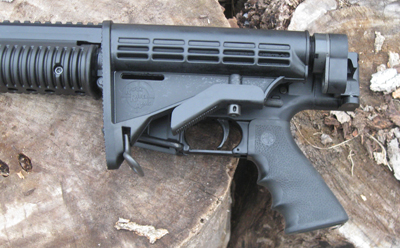

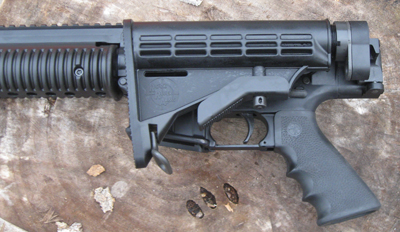
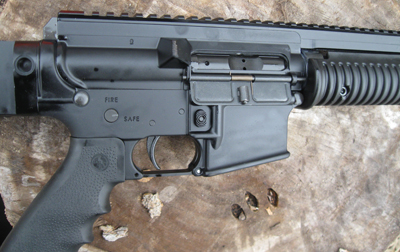


The two stage proprietary trigger is crisp and reliable. The test gun broke cleanly at about 6 lbs. It was very consistent and comfortable. The major difference on the controls is that the charging handle is a forward type, like the German H&K G3. It is ambidextrous, non-reciprocating, and folds flat on closing. It is reliable, but does take a bit of strength to work. Smaller shooters and females had trouble, but could manage with effort. The grip is a Hogue model, with good texture.
Takedown starts as with any AR, and once the receiver halves are open, the recoil mechanism is pulled down and out. This removes the operating rod, bolt carrier and bolt in one unit. It's elegantly simple.
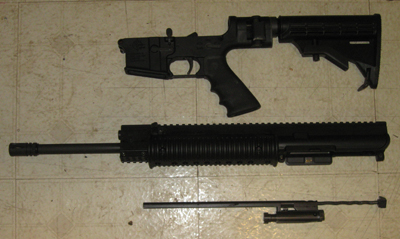
The receiver top is elevated slightly over standard ARs, because it contains the recoil mechanism. This puts it at a very comfortable height for most sighting systems - a riser is not needed. It is a monolithic rail for mounting sequenced optics.
The handguard is a bit odd looking and feeling, but very solidly mounted and useful. There is also an optional railed handguard.
The gas system has two settings, and the operator is cautioned not to use a suppressor with this weapon. A different gas block is in production for that purpose. Recoil is somewhat brisker than a gas impingement system due to the greater operating mass, but is not uncomfortable. The bottom of the gas block includes a 1" rail for accessory mounting. The gas block is very solidly mounted. I did not attempt to dismount it to examine it. Generally, pins are preferred to screws, but as it does not protrude far, and does not mount a bayonet, the heavy construction and machine screws are plenty.
We tested using several brands of ammunition, with an Aimpoint sight mounted, shooting over a sandbag. All the major commercial brands remained under 2.5" at 100 yards, in 10 shot groups. Best group was 1.55". Weather was 50 degrees F, 75% humidity, still air, at approximately 300 feet elevation. Keep in mind, this was with combat optics and sandbag, not a mounted weapon and scope.
The only stoppage was a double feed, attributed to a bad magazine, as the same problem occurred with another gun with that magazine. After 500 rounds, the mechanism was clean, and the bore only needed a pull through with a Boresnake for cleaning. That's certainly a big plus. The receiver remained cool, and there was very little oil evaporation.
The PDS comes with a magazine, a simple to read instruction manual, and a hard case. MSRP is $1685 as tested, which makes it only slightly pricier than a high-end standard AR.
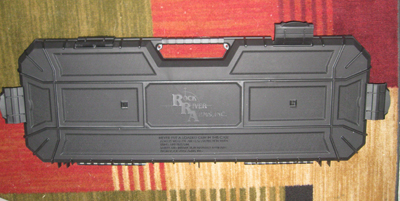
Airguns are a useful thing to have around for pest control and small game, can be backup weapons when necessary, and are legal many places regular firearms are not. They are relatively quiet, inexpensive, and the ammunition (pellets) can be bought by the thousand for little money.
The Gamo CFX Combo is a handy package, that includes rifle with muzzle brake/muffler and 4X32 telescopic sight. It shoots 1000 fps with lead pellets, and is actually supersonic (1200 FPS) with PBA (Performance Ballistic Alloy) pellets. These are harder metal and harder hitting up close, but do lose some accuracy as they cross transonic in flight.
Ergonomically, it's quite comfortable, with rubber inserts in the forearm, cheek rests on both sides of the stock, and a recoil pad. While not needed for recoil, this also improves shoulder contact and grip. Length of pull was comfortable for children and adults. The grip has enough molded checkering to aid in hold, without being abrasive. Weight is listed as 8 lbs, but it felt a lot less. The balance is excellent.

The "iron" sights are bright fiberoptic inserts, .6 mm in front, .4mm rear. This makes them clear and bright, though a little large for small game at the far reach of the range. The scope has ¼ MOA adjustments, and is solidly mounted to a rail. It's not a standard 1" rail, but an older ½" style. Rings are standard 1".
The 35 lb cocking force was a bit much for children (ages 10 and 13), but manageable by all adults, some easier than others. Pellets seat easily, action is smooth. The trigger is two stage and adjustable, but was consistent and crisp enough we didn't make any changes to the factory setting. It breaks at just under 4 lbs.
Our test range was limited by property lines to 87 feet. Temperature was 75F, 75% humidity, and calm. Once zeroed, using standard lead pellets, we were able to keep a consistent 3" group for near 50 rounds, with most within 2". The report is a crack on par with a staple gun, and penetration was through 2" of heavy closed-cell foam and 1" into a tree. This is certainly adequate accuracy and penetration for rabbits, squirrels, rats, feral cats and potentially larger game.
While not durable enough for real combat or rough use (Especially the scope), it's well-built and reliable. Nothing about it feels flimsy or questionable. As a retreat tool, recreational shooter or primary trainer, it's well worth the investment. List price is $259.95, and as always, many retailers offer good discounts.
Gamo airguns are made in Spain.
KelTec is renowned for interesting designs in modern plastic and metal. The PMR30 continues this. I'd been eager to get hold of one for months, and was quite happy when I did. I only had it for a couple of hours, so my testing was limited.
The PMR30 is a .22 Magnum pistol with a 30 round magazine. It has a hybrid blowback/locked breech system that enables it to shoot several different loadings and weights of ammo, depending on chamber pressure.
It has an ambidextrous safety, an easy to reach heel magazine release, a forward rail for lights or other accessories, and can accept a top rail or other mounts. Barrel is 4140 steel, frame 7075 aluminum, and all the supporting material is Zytel. It looks very thin and light in construction with its fluted barrel, but is quite sturdy and mechanically sound. Function was very consistent.
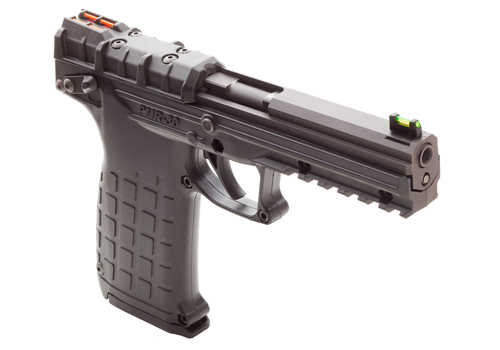
It has enough suppressing fire to last several minutes, and sufficient power for small game, or combat stops with multiple hits. With 30 rounds, there's enough ammo for either.
Empty, the pistol weighs about 13 ounces and feels like a toy. I thought it was 5 ounces, honestly. There was nothing to it. I found the grip comfortable, the controls easy to reach, and it pointed very well. Loaded up, it was grip heavy enough for good balance, but still very light.
The trigger had a little slack, but was very consistent. I wasn't able to measure the pull, but it was easily manageable (KelTec claims 4-6 pounds, and it felt right in the middle). The fiberoptic sights were bright and very friendly, aligned easily with the grip angle. I didn't do any rest shooting, but off hand was all within silhouette at 15 yards, unfamiliar with the weapon and without doing any real aiming. I just pointed and shot.
I had one stovepipe with rounds tumbled in the magazine during extreme rapid fire. I may have slack-wristed it and recoil jumbled them faster than the follower spring could move. It cleared easily, there were no other problems, and Oleg Volk and others had no issues at all.
I enjoyed the really high capacity magazine a lot. It just doesn't seem to run out of ammo, and magazines change very fast once it does.
It came with two mags, and two more spares would give 120 rounds of suppressing fire, which is plenty for evading trouble and reaching a heavier gun, or could serve as a defensive arm with multiple hits, or is potent enough for small game if stranded in a remote location. It easily fits in a console, under a seat, in a holster, or anywhere else you'd need a backup weapon. Given the very reasonable price, it wouldn't be a bad idea to have one in each bailout bag for commonality of parts and ammo.
The only other downside would be that .22 Magnum is less available than some other rounds, but, it's light enough to stockpile a few boxes ahead of time.
This is a replacement fore end for Mossberg, Remington and Winchester pump shotguns. The kit contains the fore end, adapters for all three brands and most models, nine 2" Picatinny Rail sections and plenty of machine screws for mounting.
Installation was very simple. The instructions are clear, the adapter sections are marked M,R,W for brand and F,R for front and rear. All that's involved is unscrewing the fore end nut, sliding on the ATI and appropriate adapters, and tightening the nut. It took a few seconds with a file to improve barrel clearance (and the instructions state this might be necessary).
The Picatinny Rail sections install with two machine screws each. You can install one either side, bottom, or at the 45 degree lines. Combinations are possible, but there obviously isn't room for accessories if you mount both 45 and 90 side by side.
I liked the handling, and it made for easy mounting of lights on both sides and bottom, reachable by hand while manipulating the slide, and for a quick detach swivel mount. I found the mounting strips offered a great grip, positive and comfortable. It also looks very slick and modern.
On the down side, it twists a bit more than a factory fore end, since it has a bit less contour around the barrel. I didn't find this to be particularly significant, but it is noticeable. I also wish ATI, and all other manufacturers for that matter, would round off edges on "tactical" products. The crisp machining looks great, but sharp corners ding hands. This is fixed in a few minutes with a fine file and a black marker, but I'd like the factories to anticipate this need.
If you have a tactical shotgun, this American made, lifetime warranted product is a great choice for mounting accessories. MSRP is $165, or $100 without the rail package, allowing you to attach other sections.
This also fits the Plainfield brand of carbine, the Auto Ordnance M1 Carbine and some Universal (early 1950s models), but will not fit the later Universal or Iver Johnson carbines.
Installation is drop in, though it was a snug fit, which is good. The stock has positive tension when folded but doesn't latch. It latches in the open position very positively. The stock swings open handily, and the release button is easy to use. Construction is glass-filled nylon with blued steel hardware and sling swivels. Robust, durable and very well made. It's shootable when folded, and I could still reach the safety and magazine release with my finger, and the bolt release with my thumb. Those with large fingers might find it a bit tight. However, the positive tension, rather than locking, folded action means even large fingers can operate the controls with little trouble.
Ergonomically, I found the tapered pistol grip very comfortable in size and angle, and the stock very pleasant for a folder. It didn't really feel like a folder, actually, and I was easily and comfortably able to get a good cheek weld and sight picture. It was also acceptable to my wife and daughter, who are both shorter than I with smaller hands. The butt is a little narrow, but the M1 doesn't have enough recoil for this to be a problem. Balance is right at the magazine when open, about an inch forward when folded.
The top and side mounted slings are great for either shoulder or subgun carry modes, or a single point sling.
I don't really see a need for the swivel on the pistol grip, and would rather they converted the hollow area to storage with a trapdoor. I took off a couple of sharp corners with a few file strokes. Those would be my only criticisms of this fine piece of hardware. It is American made and well worth the money.

After many delays for many reasons, I finally have my hands on a LAR8, Rock River Arms' entry into the AR10 clone market. This model is the 16" carbine, flattop, MSRP $1100.
The rifle arrived in a sturdy bright blue case, compartmented to fit a disassembled rifle of each length, with one magazine, manual, everything wrapped in plastic. This is a heavy rifle compared to an AR15, at 8.1 lbs (for a carbine, remember), but is quite reasonable for a .308.
From the rear: The buttstock is a standard 6 position, and aftermarket stocks will fit, likewise for the Hogue grip. The internals are proprietary, but it appears that standard AR fire control parts will fit. The trigger felt really odd, almost hair trigger, until we weighed it right about 6 lbs. It is just exceptionally crisp with a very sweet let off. The fire control switch is right-handed only, which is a little odd, since the magazine release is ambidextrous (button on each side), and the bottom-mounted bolt release is, also. It appears that standard handguards will fit, too (this model takes mid-length guards).
The controls are easy to reach. I do like the bolt release. Insert a mag, brush downward with thumb, and it clacks into battery. Operation was flawless for the day. This is on the rifle as delivered, with no oil, teardown, anything. It chambered and fired every time, and there were no hitches.
Here's one of the prime selling points: The rifle is advertised to, and does, accept metric and inch FAL magazines. I had a little more trouble with inch mags, but I suspect they were older. I bought ten at a gun show for $50. That's enough magazines for 210 rounds of ammunition (nine 20 round, one 30 round). That's about the price for a SINGLE competitor's magazine. Feed and function were fine with both, assuming the magazine was good. At that price, though, one can buy a case of magazines and keep the worn ones for spare parts.
The weapon is tight, well-made, with excellent fit and finish. It is well-balanced and comfortable. It felt very robust and durable, though as a loaner, I didn't do an all-out abuse test. If you are familiar with the AR15, the only relevant differences for handling are the weight and the location of the bolt release, which is lower than one is trained for, but easily managed. Since most of us slap the paddle as the hand goes down anyway, there's no problem adapting to carrying the motion to the base of the magazine well. Other minor differences are the MUCH heavier recoil spring, and the previously-mentioned excellent if unusual trigger.
The rifle came without sights on this model (other models have M16A2 style sights). This was a minor problem. I have excellent scopes, but no riser to bring them high enough above the receiver, and no mountable front sight. I managed by attaching one of my EoTechs. The EoTech is a combat sight, not intended for long range precision, but seemed to work well enough. I was within 8" of center with the first shot (before zeroing). That's good enough for combat shooting at 100 yards.
Weather: 64° F, 62% relative humidity, Barometric pressure 29.87 and falling, elevation 630 ft above sea level.
Using South African surplus R1M1, 204W, Lot A11/80, I was able to keep 4" groups of 20 rounds at 100 yards. This is 4 MOA, with 30 year old ammo, a short barrel, a combat sight with a red dot shooting at a red target. I find this acceptable.
With US surplus Lot 1-80, three shot groups ranged from 2.125" to 2.375", very consistently.
Using US military match grade XM118 LR PD (2002, Lake City), our groups ranged from 1.125" to 1.6", median 1.375". This is well within the 1.5 MOA accuracy promised, using an inadequate sight. I am impressed and satisfied. A good handloader could probably break 1 MOA, and this is with the 16" carbine, not the 26" heavy barreled "varmint" rifle.
I would suggest Rock River make the fire selector switch ambidextrous, since all other controls are. That's the only improvement I can think of.
It cleaned easily, with a little more room to get inside than an AR15. The bolt cam pin appears to go in sideways compared to an AR15 (rotated 90 degrees). The firing pin is longer. Everything fit well, had a good metal surface and a very dark parkerized finish.
For those of you wanting .308 power and range with the AR's handling, welcome home. For those wanting a reasonably priced precision rifle for target shooting, hunting, or SHTF, you'll be hard-pressed to do better. The availability of AR-platform accessories and mods are significant points in favor of both, as are the dirt-cheap military surplus magazines. One can buy the rifle and included case, customize stocks, grips, handguards and mechanicals, load 200 and more rounds in magazines, and still be money ahead of a competing AR10 clone. Add in the exceptional accuracy and strength, and it tops my list.

Top | Firearms | Preparedness Gear | Supplies | Training & Reference
Michael Z. Williamson and Jessica Schlenker (each wrote sections and combined)
This is a battery/solar panel combination.
The solar generator and solar panels were well packaged. They arrived just after Christmas, so temperature concerns (in Indiana) have made testing it tricky. The solar generator arrived partially charged, and per instructions, it was plugged into charge from the wall.
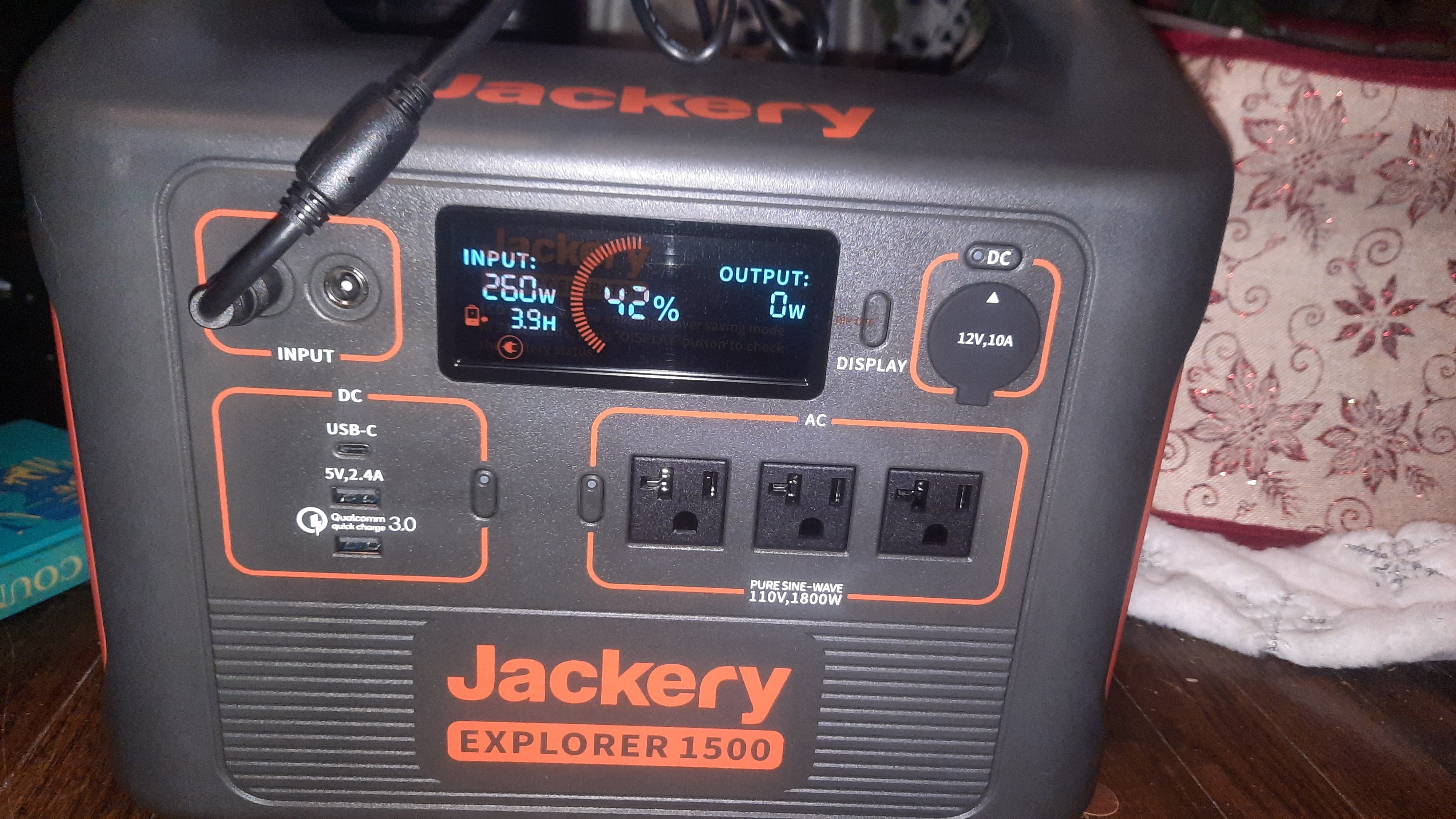
The input options are DC from the solar cells, DC from a car 12 or 24V, or 110V household current.
Outputs are three 110V outlets, a 12V automotive socket, two USB A and a USB C.
The solar generator, a Jackery Explorer 1500, and the accompanying panels are definitely geared towards a traveling need, such as camping. The folding panels are held closed by magnets, and are easily opened. They are rated IP55 -- they can take a splash, but shouldn't be left in the rain. The kick-stands are held flat to the back of each side of the panel by hook-and-loop strips, and assist in orienting them. The units fold flat for easy transport, but should not be bent, nor have weight placed on them. Each panel has a 3 port USB direct-charge option, which also connects the cable for connecting to the solar generator. On the first clear, dry day of sufficient temperatures (see end notes), I hooked up the Pop7 LTE tablet up to one solar panel in the front yard with the best light possible. The tablet went from 0% charge to about 30% charge under suboptimal conditions in about 2 hours.
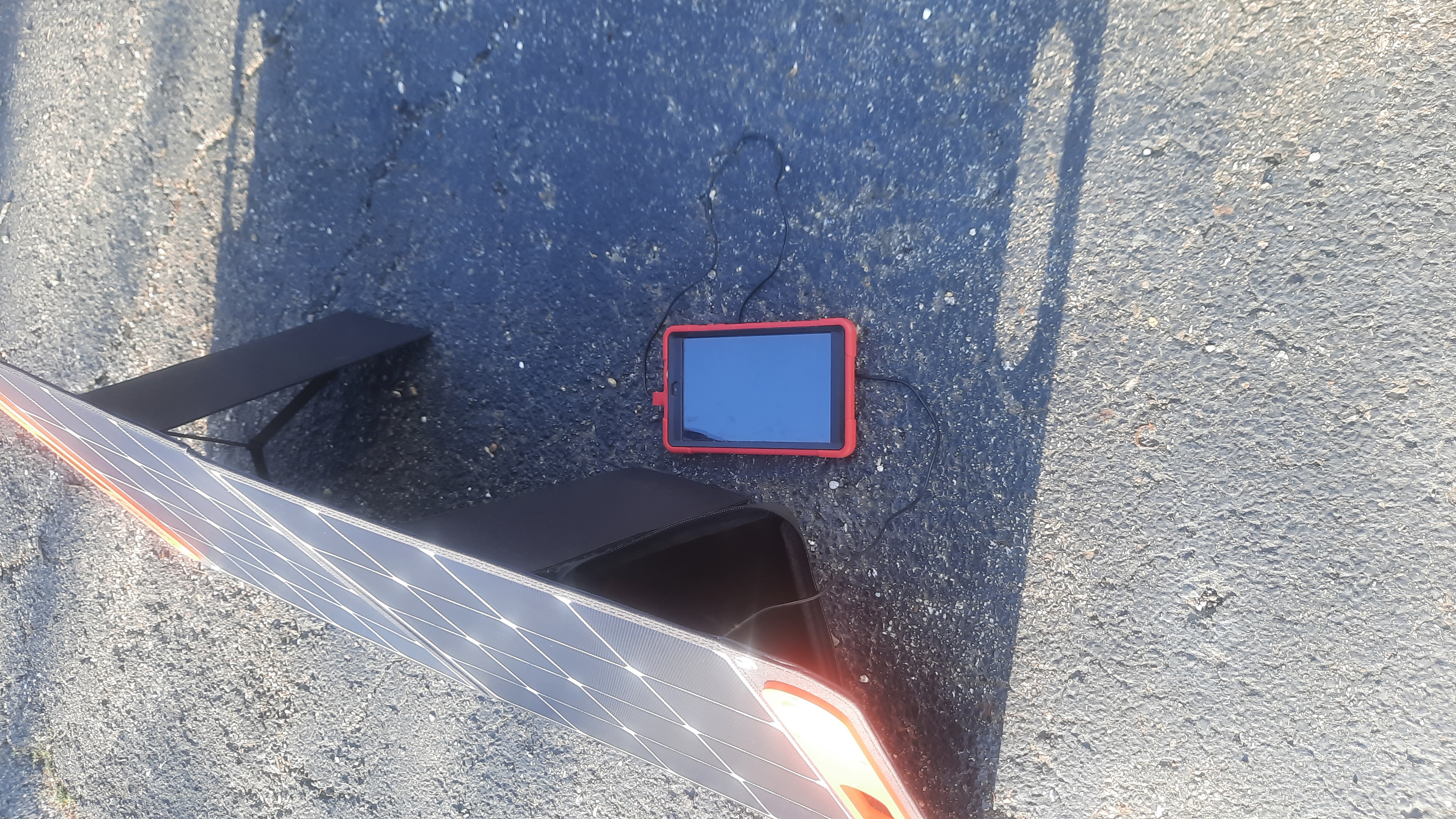
The lithium battery of the Explorer 1500 is significantly lighter than the lead-acid deep cycle batteries I have, for the solar-wind mini system that I have not yet completed. (In part, because of the battery weight.) I can pick the solar generator up with one hand, and my grade school daughter can lift it with both hands and carry it. After the generator was fully charged, it was used to power a 20w bass guitar amplifier for a couple of hours of playing, which used about 35% of the available power. The next day that had clear sky, I set up the solar generator and attached to two panels.
The set up had to wait until later in the day, when the sun cleared into our backyard, as it was far too cold to safely charge the generator outside without damage. The solar panels' cables had to run through a pet door to the generator, which meant I had to juggle positions a bit. I placed one on a standard sized round metal mesh patio table, and the other was slightly elevated (to get out of the snow) on a wood frame for the best sunlight exposure I could achieve on a winter afternoon with slight overcast and bare trees. Keep in mind that the Explorer 1500 kit ships with four panels to charge it in a reasonable amount of time, and that I had suboptimal conditions all around to test with. That being said, I tested what I could.
With two panels, with a small amount of shading on the lower panel, the input hovered in at about 150 watts. I initially plugged the panels in through the adapters. I found no significant difference in input wattage between both panels through one adapter, one panel direct/one through the adapter, both panels through different adapters, or both panels direct into the generator. Once the unit adjusted to the cables being changed, it went back to about 150 watts in.
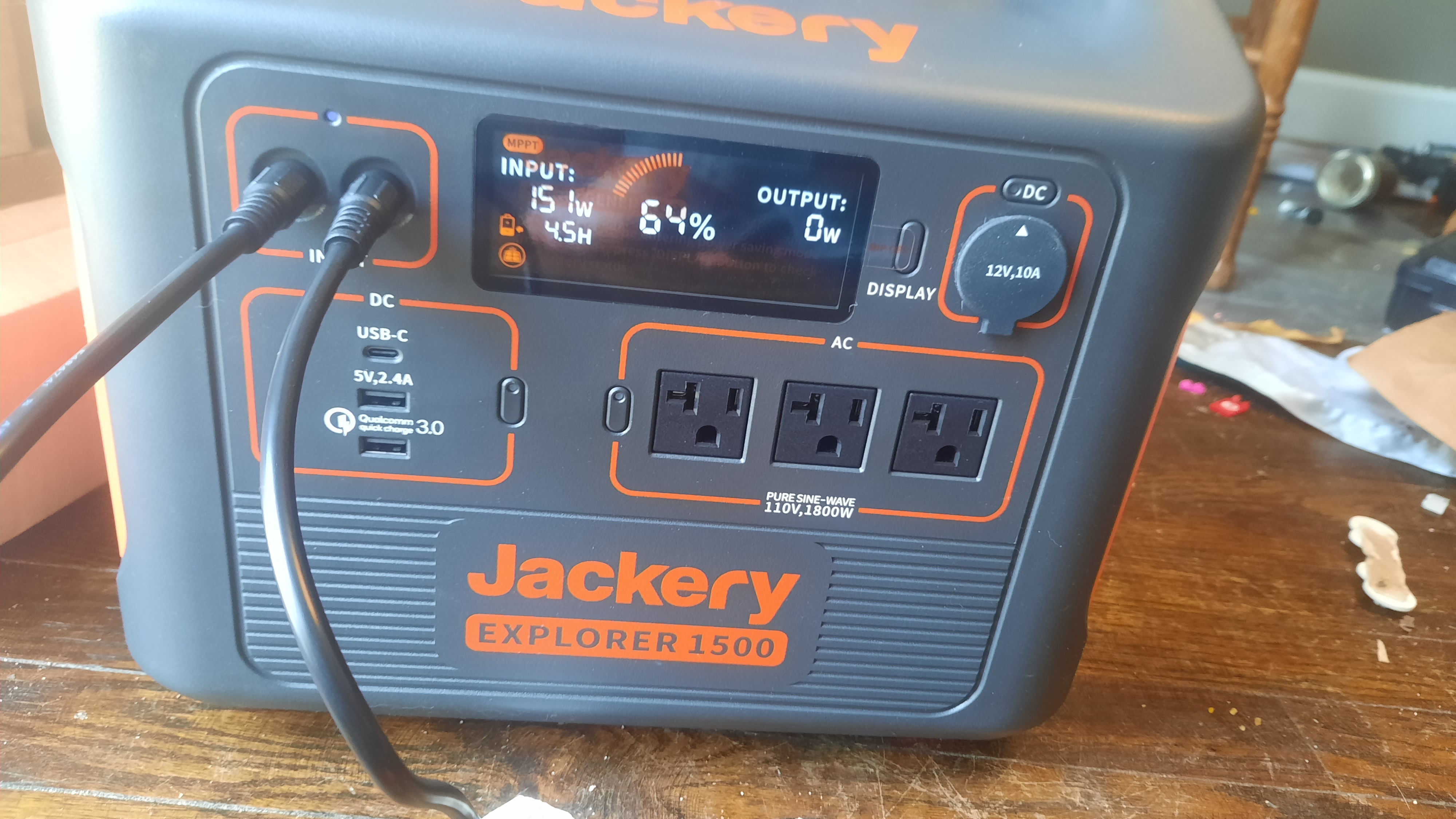
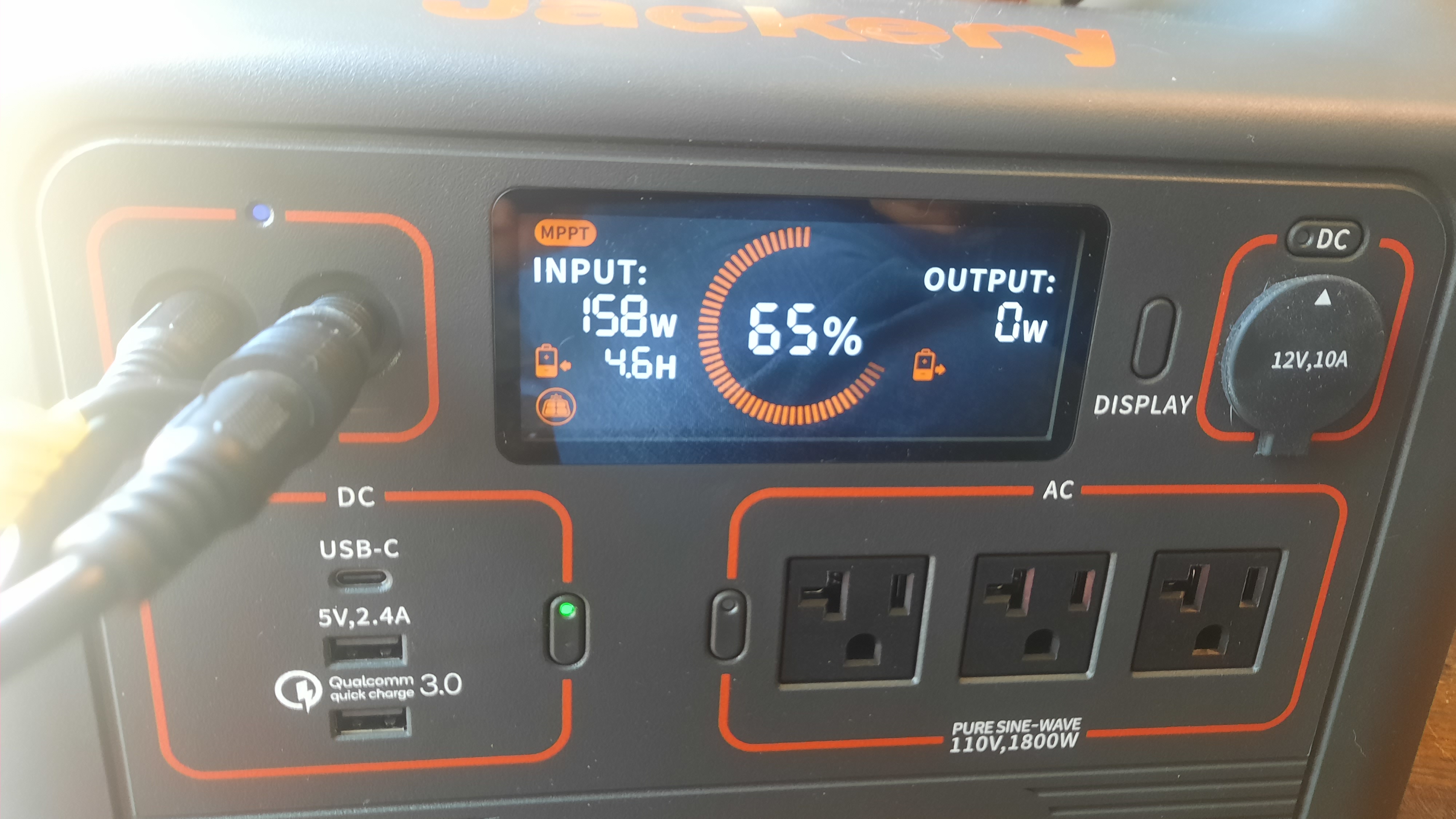
After about 75 minutes of charging, the temperatures and sun angle dropped to the point where the panels were no longer effective, and I brought them in. The solar generator gained 5% charge (from 64% to 69%) with just the two panels in suboptimal conditions. I'm impressed.
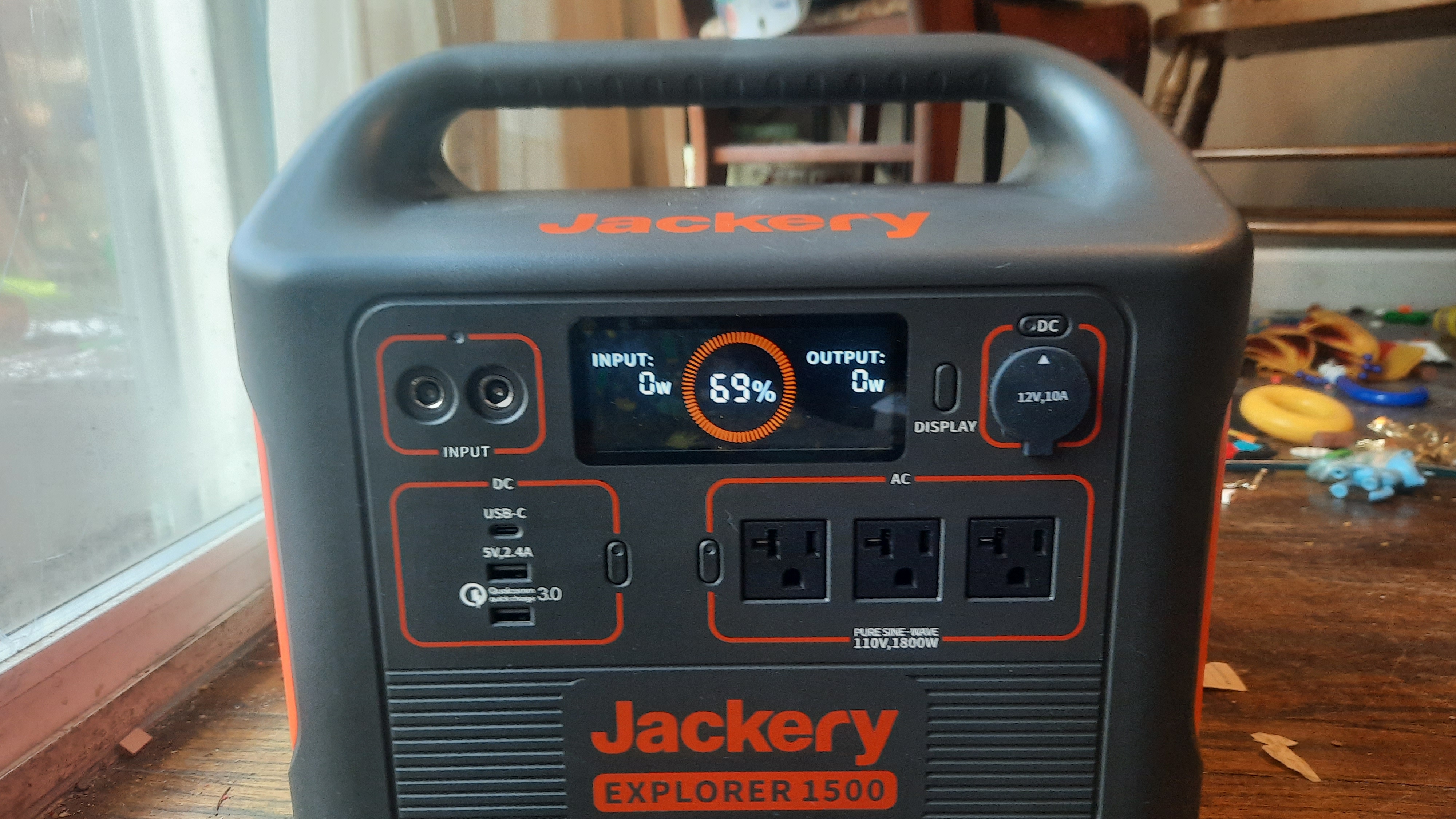
After bringing everything inside, I plugged the generator back into its A/C power adapter to bring it to 100% charge. Once it reached that, I used it to run a 20w brooding heat plate for chicks, an Ecoglow 20. This was a pretty important test, in my opinion, as the last extended power outage we suffered required that same brooder plate to be plugged into the minivan's inverter for over a day, with the van running. The solar generator's digital panel indicated that it would run on that output for approximately 50 hours. Over that duration, the generator occasionally kicked on its cooling fan, which was quiet enough that I had to place my hand in front of the fan's grill the first time I heard it to verify that's what I was hearing. The generator did run the brooder plate for approximately 2 days and a bit before its charge was depleted.
Overall, for a traveling, camping, or quiet short term emergency power source, this solar generator is fantastic and worth keeping in the toolkit for power outages.
The temperature and rain restrictions make it less than optimal for northern climes, but it would excel for Southern California with its increasingly tougher restrictions on internal combustion engines. It should maintain a standard, properly-stocked refrigerator for several hours, along with a laptop and brief use of a microwave or coffee pot. Its USB A and C outputs will power phones, rechargeable lights, and other devices, and if the solar panels are in use, those will extend the overall life, especially for the tech devices.
We contacted the company several times with questions on operating parameters, and they responded quickly, clearly, and informatively.
CLIMATE RESTRICTIONS: The battery operates from 14°-104°F, so the hottest parts of the Southwest and coolest parts of the northern tier will require appropriate shade or shelter. The charging range is above 32°F. A small grill in an enclosure (shed or such) will probably suffice.
The solar cells should of course be protected from impacts, bending, and weight. They are a bit more forgiving on temperature, with a design range of 14°F to 150°F. However, high humidity should be avoided, and direct rainfall. This is a notable hindrance here in the Midwest, or the Pacific Northwest. A tarp will provide rain protection but will need monitoring and adjustment to ensure protection while accessing sunlight. Extended humidity is hard to work around.
DISCLOSURE: the company furnished us a free unit to test and review.
I tried the following menus:
For all, add water as directed, and add optional meat and in some cases additional vegetables. These are reliable bases for a larger meal, that are edible and nutritious on their own when time is short. Note that they do require boiling and simmering. These are meal packs, not MRE equivalents.
Mango Habanero Chili: I'm not a fan of habanero's flavor. I find it ashy and scorched. In this case, though, there was enough to provide some flavor-enhancing heat without the alkali flavor. The mango added an interesting sweetness to offset the bite. While my Texas-bred wife will argue this isn't chili, it's certainly filling and tasty. They even managed to incorporate bell peppers that I also don't like, and it was still enjoyable. This selection is high in Vitamin C (40% USRDA) and iron (35%), with some Vitamin A (20%), with 8 grams of protein and 321 grams of carbohydrate as provided. This is a good meal when hiking or doing moderate labor.
White Bean and Lime Chili: This had a delicate flavor with a bit of bite that was definitely enhanced by meat and some additional hot sauce, but was certainly an interesting variation for a package. This would make a good lunch. 45% USRDA of Vitamin C, 15% iron and 10% Vitamin A. 34 grams of carbs and 11 grams of protein.
Pasta Primavera: This had a good flavor that did very well with some canned chicken added. I'd rate it on the high end of packaged pasta, comparable to bulk restaurant servings. The pasta was firm and tasty, the sauce tasted like sauce, not simulated oil blend, and the mushroom flavor was present enough to add variety. 72 grams of carbs, 7 of protein, Vitamins lower at 15% for C and 4% for A. This is the stuff to eat before you go out to chop firewood or hike a way.
Irish Pub Style Cheddar Potato: This was far more interesting than I expected. The cheese was mild, but had a bit of kick from the Parmesan, and there's chicken flavor already in there to liven it up. This would make a good side dish or first course, especially coming in from the cold. 33 grams of carbs, 3 of protein, 4% each of Vitamin C and iron.
All were satisfying, all worked as served, or with supplemental ingredients, and would be useful for traveling, serving on arrival at retreat while getting organized, or having on hand for local emergencies. They claim up to a 25 year shelf life, and the packages are tight, well-sealed, and compact. I appreciate the variety of dietary options, given some food allergies in this household. It's nice to have stuff on hand for those with restrictions, as well as for the anything goes types like myself.
I got to try the first one at a local gun show, and it made a very satisfying lunch. The rest I took home and ate over several days. All were worth eating, and I found a package made a good meal, though the rated serving size is smaller, as is usual for prepared foods.
This review is very late due to many personal issues utterly unrelated to 2020's matters. I'd like to thank them for their patience, and note that menus may have changed in the interim, but the quality has not.
Flamethrowers are primarily a tool, and accordingly, are not regulated under federal law as a weapon. As they do not fire a projectile from a fixed cartridge, they are not restricted under BATFE regulations.
The FlamethrowerPlans.com flamethrower will be recognized by some as kitbashed from various industrial components. This, however, does not make it any less effective. You can buy the plans (as the site indicates), components, or a finished unit. I opted for the finished unit.
The package is surprisingly compact considering the contents. There is the fuel tank, projector, hose and pressure hardware. The instructions are very clear and simple. Also included is a modified propane torch as an igniter. All that is required is to charge the CO2 tank, fill with fuel and attach a propane bottle.
Safety is obviously paramount with something that projects burning fuel. The instructions recommend a wet test with water first, to verify function safely. We did this, and measured a range of right at 50 feet, and a firing time of right at 1 minute. This is a shorter than historical military models, but with a longer burn time.
Fuel can be kerosene or diesel, or gasoline, and thickeners can be added to increase range and effectiveness. Diesel/kerosene are recommended both for safety, due to a higher flash point than gasoline, and because they will offer a bit more range. Thickened with left over motor oil and such, the mix approximates the Russian napalm from WWII. I've tested it successfully with motor oil and vegetable oil. It's important to agitate the mix for good blending, and I had best results with about 3:1 fuel to thickener.
3:1 diesel to gasoline gives more range and a hotter flame, without undue risk.
I have not tested a thickened gasoline mix, but it can be made by using grated soap (not detergent. Ivory is best) that is oven dried, then blended and agitated with the fuel.
CO2 is available at many sporting good shops that handle Airsoft or paintball, for about $5 locally. If you have access to nitrogen, it will offer a bit more pressure and range.
Once charged live, we tested it by burning off brush around a drainage pond. There is actual recoil, or more accurately, thrust, from firing this. The operator remains relatively cool, but the flame emits radiant heat to the sides that is palpable at quite some distance.
The pond was about 50 feet by 20, it was surrounded by heavy greenery and weeds. It took less than two minutes (two charges) of both working and playing about to clear a five foot swath all the way around.
I then tested it on an abandoned animal run on my property, about 20' square. It was full of trash trees, weeds and brush. One tank, about 60 seconds, cleared it down to ash and stalks, making it much easier to finish clearing with shears and loppers.
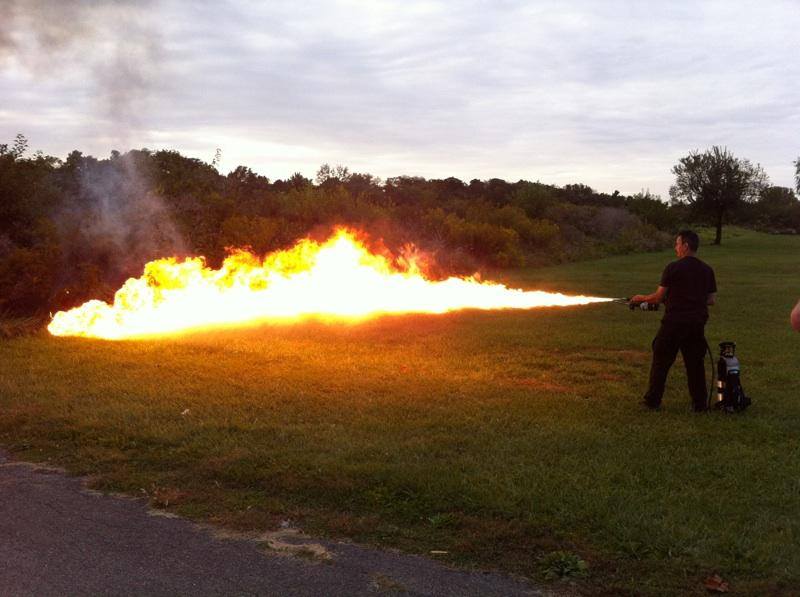
We kept a fire extinguisher handy, and I recommend doing so for safety. It wasn't needed, but if it becomes so, it would be critical. As fun as it is to operate, this is not a toy.
For brush removal around a position to clear a field of fire, it would be much faster than hand tools, assuming the fuel is available. For igniting debris, even when wet and cold, it is hard to beat. CAUTION: Do not inhale fumes from burning debris if it might contain toxic chemicals, or if it contains toxic plant matter such as poison ivy.
For a defensive weapon, it would be hindered by the prep and loading time, and the limited burn time and range. However, for protecting an emplaced position, it would work very well to deny large swaths of ground to any attackers, for firing existing burn piles for cover or concealment, and for direct distraction and concealment behind a huge ball of flame and smoke. It could be used to corral attackers into a chosen area of effect. It would not instantly stop a vehicle, but any unhardened vehicle would be rendered inoperable in seconds. In extremis, it would be instantly incapacitating and lethal within its range, causing traumatic, contaminated burns. In enclosed spaces such as bunkers, sheds or entryways, it consumes most of the oxygen, leaving any occupants with a lungful of smoke and carbon monoxide. I caution that this would have to be during a siege or mass attack when law and order has broken down. Any use as a weapon with existing legal infrastructure would probably constitute pre-meditation, would definitely attract unfavorable government and media attention, and least of all but certainly, an EPA bill for cleanup. But if it was to hand when your life was threatened, it's a trump card of psychological magnitude and terror.
We found occasional ignition issues with pure diesel, the fuel blowing right across the igniter without catching. Releasing the trigger and re-firing usually corrected this at once, and the projected fuel then lit from the second shot. With mixed fuel and oil, there were no ignition problems at all.
There are improvements that could be made. The igniter would benefit from a fabricated attachment rather than hose clamps. While the pressure bottle was secure enough, a clamp assembly would be sturdier than relying on the fittings. However, I've had no trouble with reliability.
Photo links below show the short range and effectiveness of straight diesel.
I rate it excellent for brush removal. It's unexcelled for fun, if you like controlled fire. As a weapon, limited in utility but devastatingly psychologically effective.
There are other models out there, but I have found this to be the most cost effective, range effective, and capacity effective model.
To the best of my research, flamethrowers are unrestricted in 48 states, prohibited in Maryland, and require fire marshall approval to use in CA, which, given the risk of brush fires, isn't entirely unreasonable in this case.
NOTE: I purchased my own model and use it on my property for brush removal. I was not compensated in any way for this review.
I need to review several products from this company, as they're accumulating around my office and seem to be multiplying.
First, the Nitecore Intellicharger i4. We've been using this at the house for a year now, and it's excellent.
Unlike many battery chargers, this doesn't require them to be charged in pairs. Singles of different amp hour ratings, and even different types, can all be charged at once. It handles NiCad, NiMH, Li-ion, and various types and sizes up to C. If you have a battery that needs charged, stick it in and let the charger have at it.
Every cell has come out topped off to peak voltage and power, with no issues. There's not much more need be said.
While D cells don't fit, I found I was able to use a metal shim to get one between the poles and charge it that way. This is not recommended by the manufacturer, and I offer it as an emergency option only.
MSRP is $30, and I highly recommend it.
Next is the SRT7 light, which I'm carrying in my car for business use. 960 lumens is a lot of light, and useful when setting up or unloading in the dark. For tactical purposes, it's blindingly bright, uncomfortable even with eyelids closed.
The SRT7 is a rheostat controlled light that starts with a rescue strobe, dials through flashing blue/red LED setting for emergencies and police use, red, green and blue LEDs for signaling, maritime, aircraft or night illumination, to a white setting that is very white, the brightness dialing from a spark all the way up to full intensity, then to two different strobe speeds. The tailcap is momentary or on/off, and the light remembers its last setting because the rheostat ring is a physical switch.
With the color settings, I can foresee someone taping one to their craft in an emergency.
Battery life and toughness are excellent. It's a bit large for carry in business wear, but still compact enough for a tool or gun belt, or a box or console. The large reflector increases beam throw and range over the smaller lights.
The light comes with a holster, lanyard, clip and spare switch and gasket assembly.
The SRT7 retails at $129 and is often available cheaper.
Last is their MH25 Hunting Kit that comes with the light, a USB cable (the battery can be charged in the unit via USB), the Li-ion battery, two filters (red and green), a remote switch and rail mount for weapon mounting, holster, lanyard, clip, spare switch, all in a hardshell case that would also double as a small handgun case. The MH25, in "turbo" mode, goes straight to 860 lumens, and lowers it after three minutes to conserve batteries. This is for spotlighting game (where legal) or threats, or to disorient an opponent. The user defined settings involve loosening the head slightly, then pressing the tailswitch to select mode. I found this awkward and non-intuitive. It will take practice to learn. The available settings are dim, medium, bright, strobe and SOS.
The significant advantage on this model is the onboard USB charging, and I'd like to see them expand it to more models.
Despite the awkward controls, the unit is tough and well built. If you're familiar with modern tactical lights and have a use for this, it's a good value. If you are not familiar with modern tactical light controls, or need more flexibility, I would recommend against it, and suggest the SRT7 instead.
Retail for the MH25 kit is $144, for the light by itself, $99.
The company offers lights from 12 lumens to 3500 in a variety of compact sizes. Their accessories are well thought out. Quality is top notch so far. I highly recommend the Intellicharger for anyone with rechargeable batteries. It has both simplified the task and brought all batteries to peak performance.
All these, and most of my other light purchases, have been made through FlashlightOutlet.com. Larry, the owner, is very knowledgeable of all brands, well-versed in the physics of illumination, and provides top notch customer service. He can recommend lights for any function and purpose, and offers very competitive prices.
All products in this review were purchased. I have no financial interest in the companies.
Awkward name aside, these are an interesting item.
The LED balls come as a set of three, in a black nylon pouch with a MOLLE compatible belt loop and Velcro closure. They activate with a push button on the back, which is readily locatable by touch. Once lit, you roll them into an area and they tumble, sending bright light in several directions each.
RID-3 are a low-level substitute for a flashbang device, being less distracting, but much safer. Brite Strike publicizes this fact; they are honest about the capabilities. However, for situations where flashbangs are unsafe, or for civilians who can't get them, these are still a useful device.
In a dark room with a hard floor, there is both a rattling noise and the shifting lights. They roll for about 5 seconds, then steady out, lights facing up, to provide steady illumination of the threat.
I performed several tests. These are fairly durable, but they are made for rolling, not throwing or dropping. A 3' drop caused the case of one to burst open. However, it did reassemble and function again. In extremis, consider that a bright, spinning LED hurled at a threat would certainly make them focus on it, not other people.
The rear of the RID-3 case unscrews easily to replace batteries (Which are included). They take two CR2032 each. Brightness seems to be about 20 lumens (13,000 mcd with a 90° beam), and they are rated for 20 hours.
A military/police variant in IR is available as a set of 5 with no pouch.
Especially if you have a house with a hallway with a hard surface, these would make a nice adjunct to your defensive kit. If you have stairs, the effect should be even more pronounced, understanding that the RID-3 may be damaged from the fall.
When not being used as distractions, these are still useful little lights that can be lowered into toolboxes, sumps, crates or other containers to illuminate contents. They can be set on the groundcloth, cot or end table while camping. They would work under the hood of a car or in a footwell. Anywhere a compact, up-facing light would be useful, they can be deployed. And, of course, they can be held in hand, or in a closed fist, with the closed fingers as an aperture for low level illumination for maps or gear. MSRP for the RID-3 is $55.99. This works out to about $16 per unit, plus a little for the pouch. They can be found cheaper at various outlets.
I received a courtesy set of the RID-3 for test and evaluation. I have no other interest in the product or company.
I love these muffs.
I've had them 18 months at this point, and haven't found a flaw. So let me tell you what I've found that's good.
The first thing one needs from muffs is noise suppression, obviously.
The Gold series have a Noise Reduction Rating (NRR) of 26. There are several factors that contribute to an NRR, one of which is frequency dependent. Pro Ears seems to have picked frequencies that are specific to shooting. The muffs have proven adequate for large bore rifles, .44 magnum revolvers and even make standing in the arc of a muzzle brake tolerable. They seal well around the ear, and are contoured to allow clearance of a rifle stock without bumping or dislodging.
Now to comfort, and back to those seals. The ear cups are a firm foam with a light leather cover. I've worn them for hours in hot or cold weather with no discomfort. They're hardly noticeable. There are also convenient replacement parts available for maintenance.
These are active muffs, which mean they normally amplify, and shut off when noise passes into unsafe levels. The response time on these is claimed at 1.5 milliseconds. Most active muffs work by clipping the signal – they simply shut off. The Pro Ears work by signal compression and limiting – reducing amplification on a curve. It's more natural sounding, less jarring, and means no odd static sound when working around equipment at the edge of the safe level – rather than cutting in and out, they attenuate the noise.
In addition, they're equipped with a standard 3.5mm jack to allow iPod or radio use while working. The headphone sound quality is excellent, with two separate circuits, rather than a single split circuit. The batteries are easily changed, though I've not had to often. In addition, they shut off automatically after four hours to conserve battery life. If you're still wearing them, the knob on each muff is easily reached, and clicking them off and back on resets them. The volume level is adjustable, and halfway is comparable to normal hearing. One can hear conversation, hand tools, movement, with weapon or industrial noise attenuated without obvious dips in sound.
As with many professional products, these are not inexpensive.
However, with a 5 year warranty and readily available replacement parts, they're a better investment, in my opinion, than cheaper, shorter-lived muffs. They retail at $329.95, but are available in many outlets at good discounts.
DISCLAIMER: I was furnished a free pair by a third party who is sponsored by Pro Ears, as payment for other work. I have no direct interest in Pro Ears.
USB power is rapidly becoming standard for portable electronic devices, and makes it easy to charge them from either computers, 12v car sockets or 120 v electrical outlets. However, what do you do when traveling away from such conveniences?
The Brunton Restore and its relatives provide a variety of recharging options for the traveler or outdoorsman.
Fully charged, the unit can dispense at least two full recharges to phones, cameras, GPS or similar devices, from its 2200 mAh battery. This was doing full recharges of a drained device from a fully charged Restore. I wasn't able to test Bluetooth units, but they are claimed at 7-8 recharges, and portable game consoles at 1-2 charges.
A full Restore charge on a sunny day takes about 10 hours. From a computer, it takes about 4 hours. From the car adapter or wall, it takes about 2 hours. My tests concurred closely with their claims. The unit holds charge for a long time. I was only able to test for a week, but I'm quite sure it will last much longer than that.
It comes with USB and Mini USB terminals and cords, a Mini to Micro USB adapter, and a combination adapter for car or wall. It has a small but bright LED light for locating accessories in the dark, which would also make a useful emergency foot light. It shuts off automatically after 5 minutes. It has LEDs to show charge level, and an indicator to show solar charging is taking place. The power button has a red indicator to confirm operation that shuts off after a few moments, while the unit continues to operate.
The unit is solidly built with rubber bumpers all around, a strong hinge and a sturdy case. While I didn't deliberately throw the device around, I was not gentle with it. I left it out in rain and high wind over two nights, temperatures slightly above freezing. I bumped it off tables and coolers. I consider this normal usage for outdoor conditions, and the Restore had no trouble with it at all. I put it wet in the freezer for a day, then thawed it. No issues. It provided power while still below freezing.
I did find the directions a bit unclear until I had a chance to work with the unit, but Brunton promptly responded to all my inquiries. The instruction booklet is in English, German, French and Spanish.
For backpackers or preppers needing to travel off grid while still having access to modern communication devices, the Restore is a reliable and useful piece of equipment. It retails at $120 MSRP, but is frequently available at significant discounts.
I've previously tested the Triple Eight Professional SOL Knife. The SurvivIt Tool is more versatile, and a bit more robust. The blade is AUS8 steel, and the handle is epoxy-painted steel. It's assembled with machine screws and good quality pivot and fittings, so maintenance and repair is easy, though I don't expect it will need much.
The edge was not quite as sharp as I like, and I had some trouble cutting leather thong with the hook. The serrated section, however, as short as it is, zips through heavy nylon, leather and plastic easily.
The handle is tiny, but comfortable enough even in my largish hands, and is well-designed. I tested it in a hammer grip to chisel, in a standard grip to shave and whittle, and in a side grip for both drawing cuts and scraping.
The edge geometry is excellent, and I was able to jab the blade well into various woods, both in the woodpile and on treated lumber in the shop. It sliced into wood corners easily, sawed twigs, and scraped tape, bark and leather.
The mechanism is strong and sound and remains in place while the knife is held. Keep in mind there is no guard. This is a compact tool, and its diminutive size means there are some compromises necessary. Once you have a good grip, it remains easily in hand and is safe to use. Just don't get careless.
In addition to the belt clip, there's a convenient thong hole for either neck carry, or just for a retention cord.
The MSRP is $34.95, but is usually available for less at most retailers.
NOTE: I was furnished one free for test and evaluation, which I am keeping for personal use.
A friend on an Austrian gun board introduced me to the Dead On Tools Annihilator Demolition Hammer. Just the photo was enough to convince me to pick one up for a try.
The balance is a bit forward, but there's plenty of grip surface to choke up on if needed. The hammer end made short work of a 2" concrete block, and the chisel end's impact split them readily. Note that it will need re-sharpened with a file from time to time. After the block, I tried a chunk of sandstone with some full swings. I got sparks and chipped off a few corners, but didn't make serious headway. On the other hand, I proved it was tough enough to take the impact. (A reviewer elsewhere claimed he managed to break two of them. I'm presuming there was a run of poor heat treatment in that lot. He was given free, no-questions-asked exchanges by the company.)
The claw puller on the head has fantastic leverage, with that broad head, and made ripping nails loose an amusement rather than a chore. I even hammered a few extra 20d nails in for the fun of it, then ripped them back out.
As the image shows, there are prying surfaces everywhere - front, back, head, base of handle. There's a wrench section for 2x4s, a drywall axe which would probably work for glass in an emergency (with the proper safety gear), and a couple of standard wrenches. The head is advertised to work as a bottle opener for when the chore is done, and it does, though it's of marginal use. It will take a cap off, but there are easier ways.
Now, obviously, this tool looks positively medieval, and it does make a very effective war hammer, with one side for impact, one for crushing and splitting blows, and the butt spike for traumatizing jabs. Anyone with bayonet training can grip this appropriately and hack through a crowd of zombies, or heft it like an axe and use it on single opponents.
The retail price is $49.95, but several major hardware and farm chains carry them for $30, often on sale for $25. It's worth having one in every vehicle, and one in the shop for those special jobs, and occasional stress relief.
I first got Wileys as issue equipment when I deployed for OIF. I still have the same pair, and use them heavily while driving, shooting, and working with tools.
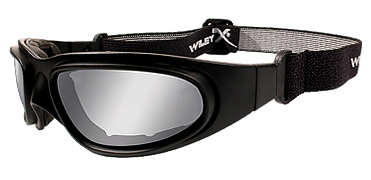
Let's start with the most important part, the lenses. These are MIL-PRF-31013 ballistic certified. They are incredibly resistant to scratching – sandstorms, construction, daily wear and carry have not affected them. I even wore out the rubber seals mentioned below, and the lenses were still pristine. They're still so transparent I'm not even aware of the lens, and I'm someone who has never needed correction. However, if you do, they can make prescription inserts of the same material. The lenses snap easily into the frame and are very secure, but can be replaced without undue difficulty. They also came (this model) with a ventilated rubber face seal that was indispensible during sand storms.
The frame is flexible enough to be tough while remaining sturdy, and extremely comfortable. It's very modular. You can swap lenses from clear to smoke to prescription, change from ear pieces to elastic strap with a clip connector. The mounting screws for the hinges are full-length stainless. There is a slide on strap for the regular earpieces, with a nut to tighten behind the head. This causes the frame to bend and conform to the face to seal against dust. Even with that tight, the frame is flexible enough to let you pull the glasses up or down over the ears – we had to do this several times a day when moving in or out between facilities and sand.
Most importantly, their customer service is exceptional. When I eventually broke an earpiece at the hinge (and it only broke partially. It was still wearable for the week), their rep assisted me in identifying which model I had, and sent the spare parts gratis, even after I offered to pay.
Wileys are not cheap, but I can't think of any improvements to make, and they're useful for any task that requires UV protection or safety lenses. Given the engineering and quality, I find the price very reasonable.
This tiny knife is a very durable piece of hardware.
Construction is of steel, with a hard phosphate or oxide finish. The pivot is adjustable with a spanner wrench, very smooth and has slick bushings. The lock is of the rotating handle design, with strong pins to hold the blade rigid when open. The handles swing easily open or closed, and remain in place in the hand without slipping.
The finish survived being dropped on a tile floor unmarked. The handle did open a fraction – the detent is fairly light.
As can be seen from the photos, it's very small open and closed, with a blade about an inch long.
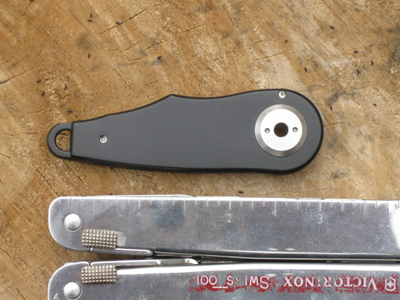
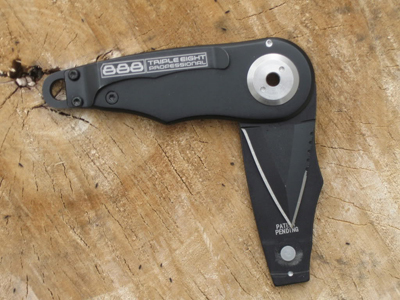

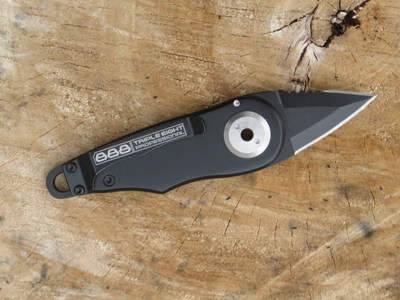
This model has one side serrated and one plain, in AUS8 steel. The serrations are surprisingly fine with good geometry to cut rather than drag.
The serrated side was able to saw through an electrical cord in few strokes, with no damage to the teeth. The plain edge cut a 3/8" bevel all the way around a firewood log and still shaved hair. I jabbed the point in and bent until it popped a small divot of wood out, without damaging the tip at all. This was a fairly brief test, but the knife still looks brand new after it.
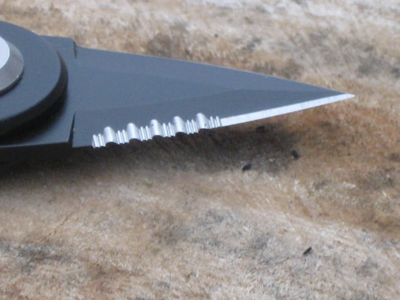
The design is similar to the OSS Thumb Dagger, and that is the best and most comfortable grip to use to hold it (See photos). It excels at chores such as opening packages and cutting cord, and easily stabs containers open. A variety of tests were conducted and it was still new looking and sturdy, and still shaving sharp. No tests were conducted on metal containers yet.
The knife also has a lanyard/key ring, and when folded is about the size of most common keys and keychain tools, so is very discreet for carry.

For those who prefer other blade designs, the company offers a flat chisel and hooked cutter "CopTool" for seatbelts and such, the "WrightKnife" that is single edged with a contour for the thumb, the "RhinoKnife" with a caping blade with gut hook, the "TalonKnife" with what appear to be line and cord cutters built in, and the "Kirkidashi Knife" that is a miniature damascus tanto. Chinese manufacture is quite standard in the blade industry anymore, but all are designed by well-known American bladesmiths, built under American license. The workmanship seems quite sound.
These would make great small knives for pocket carry, or as emergency tools for the vehicle. They're small enough to carry in shorts or even a swimsuit pocket, or to keep in a vehicle console with a lanyard for easy access.
Most models retail at $34.95 and will undoubtedly be cheaper through most retailers.
I can't speak highly enough of this company and their products. I received one in 2003. Since then, I've carried it all over the world including a war zone, on business, to conventions, while driving.
I've stuffed it to the point where I needed a knee to apply enough pressure to close it. It's been dragged, carried, tossed, shoved, buried under luggage and cargo, through airport security hundreds of times, and there's not a loose seam or worn zipper anywhere. It seems to be as indestructible as textiles get. While this style is no longer available, it's demonstrative of the breed.
Timbuk2 started in San Francisco, designing and making bags for bicycle messengers. They still act like a small company in terms of service and support, including a lifetime guarantee on materials and workmanship, spare straps and hardware, and a 20% discount on a new bag for trading in an old model, in any condition.
My particular model is the Data Dump. When stuffed to what should be a breaking point, it exactly fits the carryon size limits for aircraft.
The shoulder straps are comfortable, contoured, designed for people with shoulders, adjustable, with a hip belt.
The laptop compartment is padded enough to cushion a computer, and to pad against the wearer's back.
The accessory pockets are integral, collapsible, and well thought out, with lots of mesh, slots and loops for compartmentalizing stuff, from business cards and pens, to toiletries and computer accessories. The main compartment opens wide for access, then zips closed and latches down to minimize profile.
The outside is tough and sufficiently padded to keep contents secure.
The bottom is a tough rubber over nylon.
There are thumb loops/carabiner attachment points on the shoulder straps and back, and a sturdy, solid carry handle atop with a stitched in piece of hose to reinforce it.
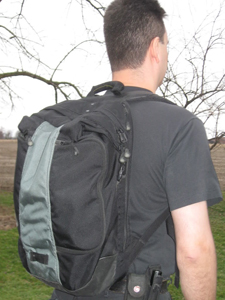
Their models change regularly as new technology is developed, and they offer not only a variety of colors, but a build-your-own option for style, size and color. Some of their bags are imported, made under good supervision.
The custom bags are American built (it seems more appropriate to say "built" rather than "sewn" for these engineering masterpieces).
You'll pay a little more, but the quality is beyond compare for a travel bag/day pack/briefcase of this type. For a smaller, unobtrusive BOB or a reliable daily carrier, I can recommend this company's products without reservation.
After my successful test of ShelfReliance's Cansolidator, I acquired their full size Harvest system that holds up to 600 cans.
The Harvest comes in two cartons, a tall heavy one with the metal structure, and a big, double-walled carton with the can racks. The instructions are included, and quite straightforward. One or two pictures weren't as clear as they could be, but a look at the components straightened everything out.
While I was able to put the system together myself, I'd recommend a second person. It's not particularly complicated, just large. The steel frame slots together with keyhole fasteners, and they're quite snug. I used a rubber mallet to get them together. This is a good thing, in my opinion; it means it won't come apart easily. The tracks are thick, rigid plastic.
You'll want to ensure you have plenty of space to assemble this beast: it takes access from at least two sides to get the racks locked in, lined up and properly spaced, and I recommend the caster upgrade--Once it's in filled and place, it is not going to move otherwise.
This system is well-designed. It takes most standard sizes of can, small, medium and #10, and can be customized to take various proportions of them. It adjusts for cans as short as tuna cans, and for the tall ready to serve soup cans. It takes standard peanut butter and condiment jars, too. I would recommend a padded underlayer if you plan to store glass jars, just in case.
Each rack holds about 15 standard cans (the larger racks being proportionally deeper), but I was able to bump the rear cans on the feed rail, and double stack a couple of extras. The tracks are very strong.
Included is a set of magnetic labels for most common canned products, plus some blanks for making your own, plus some specialty ones for canned long term food (shelf life up to 30 years) that Shelf Reliance sells. (I haven't tried these yet, but their prices are quite reasonable and competitive and their quality so far in my tests is excellent.) This and the open design makes it very easy to find what you need, and keep track of the amount on hand. First In First Out means all you have to do is see what's low, buy more and feed it in from the front.
Pluses:
Well-designed, modular, adjustable for most cans and several other containers, sturdy, compact, easy to use, easy to assemble, clear documentation, _made in America_, half the price of some competing systems. Shelfreliance is happy to customize parts for you if you want to store more #10s, or more standard cans, or fit the unit into a narrower or shallower space. They also sell component pieces individually for expansion, and have scratch and dent sales for those on a budget.
Minus:
No actual negatives so far. Just be aware that it takes a while (a couple of hours) to put together just because it's so large--there are 31 racks on the standard model. You really should buy the casters if you ever plan to move it.
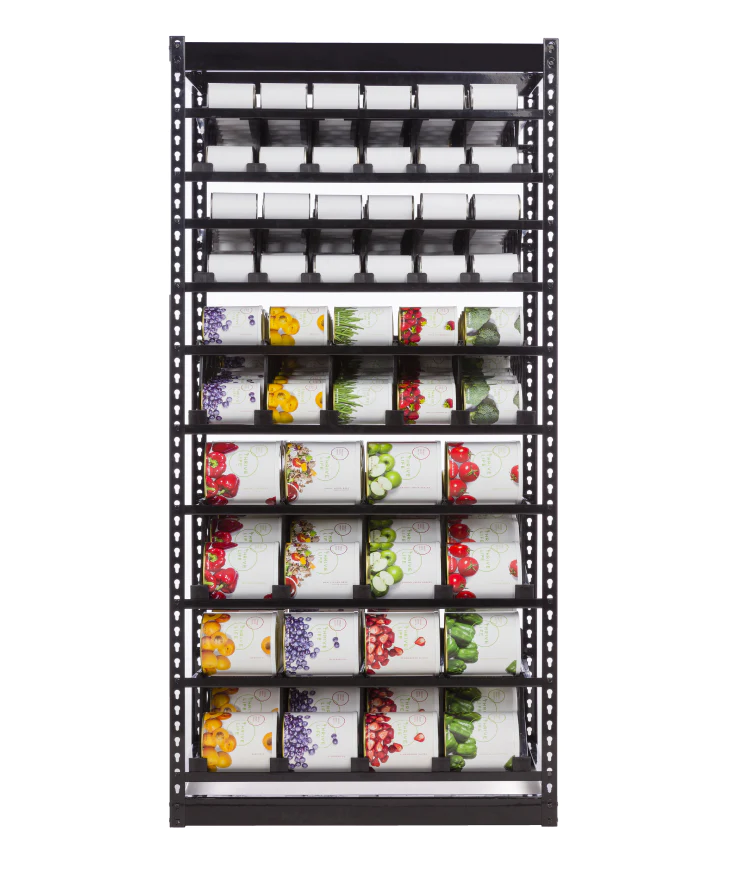
2022 Update - Webmistress here. When Mike wrote the original review in 2009, I actually purchased one myself, and I got the casters. I also bolted a pegboard to one side to help keep it aligned. That unit moved with me from Texas to Indiana with minimal issues, and is still going strong. Shelf Reliance themselves have gone through a couple of iterations, and our original units are no longer made. However, the new version can be found at Shelving Variety Can System or ThriveLife - Variety Can System.
My order for two Cansolidators was filled very promptly, and they arrived within the week.
These are a common concept for people storing canned goods in bulk--a first in, first out (FIFO) rack. New cans go in the top, old cans dispense out the bottom.
The Cansolidator is modular, made of a very sturdy and flexible plastic, and the rails are numbered to make it easy to set consistent widths. Each unit contains four top and four bottom rails, and five vertical rails/spacers. You can extend the rails to make wider units, and use additional bottom rail sections to build vertically.
It was just slightly too tall for my kitchen cabinets--it wouldn't quite fit under the shelf, but may fit in newer ones. It's also fairly deep. Shelfreliance also sells smaller units intended for cabinets, and larger, freestanding units up to "The Harvest" that will hold up to 600 cans, and can be adapted to fit a smaller number of #10 cans.
I managed to adjust the unit to fit three slots for standard cans and one for smaller cans (fruit cocktail and beanie weenie sized cans). A standard modular plastic shelf system will fit a Cansolidator section 6 cans wide, with enough room atop to fit a flat of additional cans between it and the next shelf up. This dramatically improved the cubic efficiency of our canned goods storage.
My only criticism is that a basic unit is not quite wide enough, by about 1/2 inch, to fit four rows of regular cans.
I will definitely be getting more of these, and one of the larger freestanding racks, to improve our food storage.
Top | Firearms | Preparedness Gear | Supplies | Training & Reference
It's a good idea to have an emergency food supply in one's bug out bag, but it needs to be something that doesn't decay, leak or spoil, and has a good shelf life in possibly extreme conditions.
Enter the Mainstay rations. They're packed in what feels like a heavy mylar-lined foil, rated for 5 years, and can withstands temperatures of -40° F to 300°F (-40°C to 149°C). They meet USCG and DoD standards for packaging. They're in convenient 400 calorie bars, each constituting a meal, which make management easy, and eliminate trying to break pieces, so as to minimize loss in serving. A one pound pack is more than enough for a day under normal conditions. Obviously, extreme circumstances may require more.
Emergency rations are unusual if you're not familiar with them. These are small and dense, basically a giant, semi-sweet sugar cookie with lemon flavor and vitamins/minerals. They're heavy enough not to crumble too much, but light enough to eat, sweet enough to be enjoyable, not so sweet as to be candy. You won't feel full after eating one, but you will have enough calories and nutrition to get where you're going. As the chart shows, you'll have more than the USRDA of most nutrients. I'd recommend supplementing with other food, especially edible plants, but for the short term forced march, these are the thing to have.
These are similarly packed, in small, 125 ml (just over 4 oz) servings. The packs are not overfilled, and strong enough to take a lot of tossing around. In my test, they took a crush weight of 200 pounds without bursting (I stood on one), which is tremendously more than a typical bottle will take. If one pack should happen to get punctured, loss is minimized. Shelf life is five years, and the package is proof against oxygen transfer and spoilage.
The company is honest, with no blather about mineral springs, etc. The municipal water source is listed, as is packaging date and lot number. The price is competitive with brand name water, or bottles from a machine or vendor at remote events, making them even more attractive.
The only down side is they are a little tricky to open. Once they tear (you'll need teeth), the best strategy I found is to seal lips around the package and squeeze gently. After the first mouthful, it's more controllable for pouring, etc.
A dozen of the water packets and one of the large food bar packs will give you a couple of days without worrying about energy levels or dehydration, assuming a temperate climate and proper clothing. I recommend both products.
2022 Update - Updated site links. Original site blocks adblockers. Amazon links are best price currently found per oz.
A case of 12, 27-ounce cans of beef cost $63$110 (2022 price) plus shipping. I called to order, didn't have to wait, and they processed me in about two minutes. The case arrived as fast as UPS could deliver, double-packed in sturdy cardboard and well-labeled. The meat is cooked, lean, in juice, and quite tender and tasty. A test of chili and of emergency stew from canned goods in the pantry gave quite good results--once shredded, the texture and flavor were good. The labeling and site are very plain. You're getting quality, not advertising. I recommend keeping a few cases on hand for natural or economic disasters. You'll still eat decently well at a very inexpensive price.
2022 Update - Grabill Meats now has online ordering (for those like the Webmistress, who hates calling people). You all know how inflation has gone, so it should be no surprise that the prices have increased since 2009. We purchased a restock a few months ago, and the quality remains top of the line.
Top | Firearms | Preparedness Gear | Supplies | Training & Reference
Book review: Destroy the Enemy in Hand-to-Hand Combat: An Authentic Field Manual of the Red Army
[Paperback]
Gen A A Tarasov (Author), Boris Karpa (Translator)
Translated from the Soviet WWII original. Boris Karpa has done an excellent job of maintaining the flavor of the Soviet manual, keeping the read interesting, and making it reasonably clear. Some sections are a bit awkward, but it seems to be from the original writing, not a translation difficulty. Those areas that don't translate well are covered more than adequately by the original illustrations.
The first half of the book covers moving in combat and under fire. It addresses movement over terrain, over obstacles, in and out of trenches, and scaling of walls. Most of it should be familiar to anyone who's read similar military manuals. The basics don't change. There are a couple of neat tricks I haven't seen elsewhere, for small unit tactics crossing obstacles, as well as for entering close quarters while keeping the weapon ready to engage.
The second half deals with actual combat. There is a lengthy section on how to throw grenades from various positions, that won't currently be of much use to most readers, but is certainly useful for information, research, and for studying body mechanics, since one can throw other items besides grenades.
The next chapter covers the basics of bayonet and stock, and the explanations and diagrams clearly show the maneuvers, and the text covers specifics down to hip rotation and foot movement for generating the most power in the attack. I found this section to be a very good summary of melee, and could be useful in event one needs to defend a position. It does go into detail on using the bayoneted rifle like a spear – I recognized the techniques from medieval manuscripts and Asian martial arts. This is very useful information, especially for one using a traditional bolt action rifle with its long stock. One can use a full-length rifle as a very effective pike and club when empty, jammed, or when ammo is at a premium.
The manual advises practice and rehearsal of various other suggested moves on an individual case, basically, to learn one's body and how it moves.
There are some supplemental descriptions of fighting into or out of a trench, actual bayonet fencing against an opponent, some stock strikes and blocks. This was the twilight of the bayonet, as far as training, but most of the old tactics are still in here, and worth knowing.
The final sections cover in extremis – using a standard shovel or entrenching tool against a foe with a bayonet, and even bare hands if need be. The reader is motivated to believe the fundamental fact that the mind is the real weapon.
I found Destroy the Enemy in Hand-to-Hand Combat to be a readable, useful reference. It's not a large book at 45 pages, but it has quite a bit of content, and the original pictures are well-executed. It's also an interesting historical reference to the Soviet combat mindset. Mr. Karpa has done an impressive job with this translation.
NOTE: I received a downloadable .doc file for review. I have no financial interest in this book.
This is a great video and useful resource. Not only is it based on a lot of research, but on more than a decade of home farming in central Texas, which is certainly one of the tougher environments in America to farm in.
Very clearly narrated and demonstrated. It's a little handheld and shaky at the beginning, which emphasized the small scale involved, but professionally filmed and edited after the intro. This is a farm for a family of four, run very efficiently and productively.
It starts with a chapter on the most important aspect: Water. Subjects include collection and distribution, with some welcome attention to cleaning - often overlooked in other publications. Rainwater, graywater, well and commercial water sources are all covered, with extensive discussion of catchment and cleaning of rainwater. Ponds and catfish are mentioned, too.
The chapter on gardening covers critical issues such as shade mapping, soil types, compost production, including safe composting of human waste. The narrative is quick and clear, and mentions lots of documents, helpfully provided on disk 2.
Rabbits. Raising and butchering rabbits – I'd recommend adding a guthook and shears to the demonstrated method, but it's good to learn how using just a basic knife. This section is professional and clean, but the killing and butchering of a rabbit is probably not something to show children who are not familiar with the realities of meat.
Also covered is how to use the rabbit waste for compost, and the rabbits are fed off shade trees and garden waste, for a very efficient cycle.
The chapter on poultry is almost exclusively about chickens, kept free range for eggs. While chickens are certainly edible themselves, the eggs provide a much more efficient source of protein and are useful for cooking or trading. Here again, the chickens serve another purpose, eliminating ground insects and weeds and providing fertilizer.
Dogs are useful, even essential to protecting a garden from the predations of wildlife. There's a good discussion of socializing and raising them to respect the human and keep paws off the other animals.
Perennials include fruit trees. It's important to work with fruits that thrive in the area, not try to force commercial crops to fit. Geese make a good adjunct to an orchard, providing fertilizer and winter eggs.
The chapter on Essentials covers calorie rich foods, such as grains and tubers, natural pesticides, first aid, contour mapping and covers how to check imports (hay and other composts) for toxicity.
There are summaries at the end of each section. Each chapter has great tips on saving power and resources by nesting and stacking various plants, animals and tools to minimize waste, labor and costs.
Overall, it's very clear. It seems a little chaotic in spots on a first viewing, but there's a lot of inter-related information here that has to be covered. It's worth watching several times and keeping as a reference. Very watchable, very lively, and what a good documentary and summary instructional video should be.
The second disk has the extensive documentation, references and recipes. There are sections on composting, companion planting for nitrogen fixing, acorn flour, tanning hides, soil amendments, processing of various plants for seed oils, root cellar construction, a solar food dehydrator, and various fruits that are uncommon these days, such as persimmons and pawpaws.
I highly recommend this as an overview, aid and morale booster for anyone planning to do home gardening or farming to improve their sustainment and off grid capabilities.
2022 Update - Another older review, and links/placements have changed. The new link has been added.
The sport of Sporting Clays involves a variety of size and color clay targets thrown in high arcs, low fast passes, rolled along the ground, and in pairs overhead, which are good simulations of real animal movements. Besides being a good way to tune reflexes, it's a lot of fun. This is a sport that translates well to both survival hunting and defensive shooting against surprise, moving targets.
I shot trap a couple of times about 20 years ago. Since then, all my shooting has been rifle, pistol or riot gun at pop up or fixed targets. This was effectively a new skillset for me.
Before the class, I received an instructional book and DVD. Both were clear, easy to understand and easy to pay attention to. There is a drill for learning the proper movements with a shotgun, and it was very useful. Upon reaching the course, I already had the basic movement ingrained.
OSP is run by Gil and Vicki Ash, with lots of hands on. Classes are kept small, so there is typically one instructor for each five students or less. By the time I'd finished one station of shooting and gotten ready for the next, I had a coach at my elbow.
Gil gave us background on both the sport, and on the related human reflexes, kinetics, neurology and optics. It was a down to earth discussion, but Gil has consulted with researchers on the science behind these. How to learn is as important as the learning itself. We had a long discussion over muscle memory, coordination, dominant eyes and hands, and related matters.
The premise of their method – and they are both amazing shooters with a lot of competition credentials – is that 3-5 seconds of target travel time is more than enough to locate, point, mount the shotgun and shoot. Think of merging with traffic from an on ramp. The car has to be placed precisely between two others moving at a high rate of speed, but if approached in a relaxed fashion, rather than gassing and braking, it's a fairly simple task. In this case, one sights and moves with the target, mounts the gun, and shoots. This should be an instinctive, natural movement, without a lot of analysis of point of aim, lead, etc.
The coaching was cheerful, conversational and full of humor and sarcasm, but very precise and insightful. We determined my stock was too short, choke too tight, and that my familiarity with high-sighted military rifles was hindering my shotgun mounting. It took a good part of the day to tweak the new movements, but I noticeably improved, and more importantly, learned the skills I needed for further improvement, and gained an understanding of how to analyze my own shooting. I did indeed find that 3 seconds was plenty of time to spot, mount, shoot, and repeat for the second clay of a double.
Gil and Vicki love shooting, love teaching, and their classes are a lot of fun, as well as being packed with learning. Their rates are very reasonable, available singly or for groups, and they offer excellent rates for groups at your location.
This is one of the card decks that doubles as an information source, in this case, on disaster response.
It's printed on very sturdy plastic coated stock, about twice as heavy as typical decks, but the same overall thickness. It's well organized, with each suit covering different areas--
The aces serve as indexes, and Jokers as forewords. It's a handy pocket survival book summarized in a card deck, with pictures of things like splints , shelters and navigation techniques, lists of medical, clothing and other supplies, and charts of procedures.
The summaries are concise and very clear. It's heavy on the first aid, but has good, practical guidelines for quick emergency shelters with native materials or tarps, and a summary of map and compass that a layman can use to get a fix on location or direction to travel to find help.
If all else fails, you can always play solitaire. Eventually, someone will show up and tell you to play the red 9 on the black 10.
For $7 retail, it's a worthwhile addition to a bailout kit, especially for laymen traveling in even slightly remote areas - parks, backpacking areas or wilderness preserves.
Top | Firearms | Preparedness Gear | Supplies | Training & Reference
The following items have been discontinued by the manufacturer or the manufacturer has since gone out of business. They are shown for historical value.
For those of us with AR type rifles or those with similar sights, this is a useful piece of kit. One of the issues with a tactical rifle can be the light mount. Should it be under, to one side, and where should the switch be mounted? How will it work when shooting over or beside a barricade?
Roschworks' SLM1 avoids all this by mounting the light directly over the barrel, with an iron sight above it.

The unit is milled from one piece of 7075T6 aluminum, and mounts solidly to a standard rail. The profile is just right for co-witnessing optics and iron sights, and the sight is solid and does not drift under fire. It adjusts easily with a dedicated tool, or a pair of fine pliers (in an emergency). With the light in this position, the target is fully illuminated inside the sight window, with no shadows or dark spots.
It's very easy to activate by rolling the thumb up around the handguard, and that position fits perfectly with several modern stances and grip styles.
Any standard 1" tube light should mount without issue, and it will take reflectors under 1.5" without interfering with sight pattern. If you need to bottom the sight for long range zero, it may be necessary to choose a light with a flat on the tube - the post will protrude into the ring at bottom seat.
This is a simple, reliable and trouble free piece of gear that can reduce the clutter on your modern tactical rifle.
They also have a unitized item with the light permanently installed, producing 250 lumens from one CR123 battery.
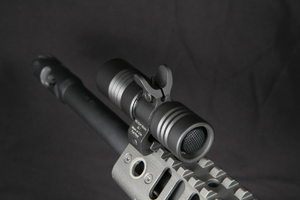
Roschworks products are made in the USA.
NOTE: I purchased one of these from the company, and have bought other items before. I have no financial interest in them.
The X7 is billed as extremely accurate, durable and low maintenance. To test this, the first thing I did was degrease it with brake cleaner.
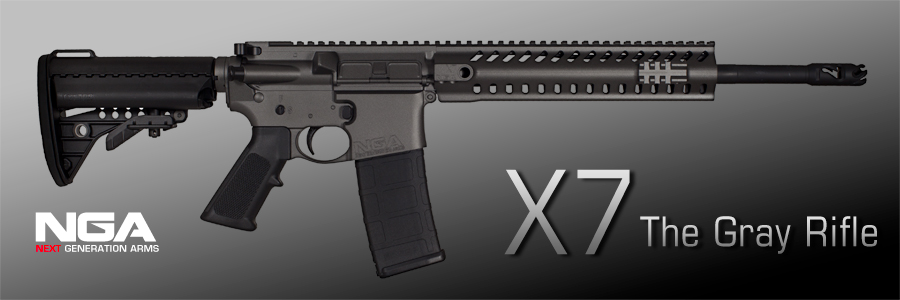
Upon examining this rifle, one realizes a lot of effort went into ergonomics. The VLTOR stock has Quick Detach (QD) swivel mounts on both sides, the receiver end plate has one and there's one on each side of the hand guard. The hand guard is milled from two pieces of 7075T6 aluminum so well fitted they look like a monobloc. The handguard and rails run forward to the gas block, with side mounted rail sections as well. Next Gen is making those removable for future models.
Mechanically, it has a crisp Geissele trigger that breaks consistently at 5 lbs, a Noveske stainless polygonal barrel, mid-length gas system, BCM bolt carrier group (properly staked) and Gunfighter charging handle, a billet lower with forged upper, a proper impact extruded 4 position buffer tube, also staked, and a very advanced ceramic coating all over. This provides a low friction surface that most gas particulates simply can't adhere to. The magazine well is flared and cut so even Magpul PMags and Thermolds will drop free easily. The rails are perfectly to spec so no force is needed to slide accessories on. The muzzle brake is loud and blows a lot of gas at bystanders, but recoil is reduced to negligible levels. The charging handle can be slightly stiff for smaller shooters, due to the heavy recoil spring. Sights are optional but available, since most shooters prefer to choose their own.
From a 16" carbine, sub 2" 10 shot groups were easily attainable at 100 yards using a scope, good commercial ammo and a sandbag. Best group so far was 5/8" (300 feet ASL, 53 degrees F, 55% relative humidity, using Federal Premium 62 gr ammunition.)
After several range trips, while prepping the rifle for photos, I found the charging handle tough to work. It felt as if it were jammed. It is possible for a weapon put away wet to rust shut due to carbonic acid. The X7 was simply a little sticky with congealed carbon inside, and a few cycles of the charging handle freed it up. The carbon had stuck to itself inside the BCG, rather than to any components. (There is some accumulation on the tail of the bolt, but I expect it will remove easily when I do clean it). There was no corrosion or damage.
I had a defective magazine that caused problems, including a double feed. The round was jammed between carrier race and bolt face, and would not dislodge. With a staked carbine extension, there was no way to easily remove the BCG from the rear. The only way that presented itself was to grasp the bullet tip with needlenose and crush it enough to get a firm grip, then beat the charging handle back with a rubber mallet. An ordinary charging handle would be destroyed by this process. The Gunfighter was unharmed. The ceramic coating on the handle and the ejection port was unharmed. The coating inside the receiver and on the bolt and carrier was unharmed. It literally looked new when done. Please note the magazine had similar issues with two other rifles, and was disposed of.
I can't think of another precision rifle that can take that kind of beating and come back for more.
At 530 rounds, a steel case failed to extract. One single drop of oil freed up the extractor enough for it to grip and cycle. I degreased again, and ran another 720 rounds of brass without issue. The tight chamber prefers brass, but will handle steel if it must. Please note that brass is recommended by Next Generation Arms, and most other manufacturers.
During one range trip, the rifle was left lying open in the rain between shoots, for 6 hours. It functioned flawlessly from the 1250 round mark to the 2000 round mark. Three days later, the weapon was dried, the bolt carrier group wiped clean, the bore swabbed dry, and a couple of drops of Kroil placed into the barrel extension, which was finally showing some minor discoloration from the carbon and water.
So, in over 2000 rounds of wet, dirty use (so far), there was one malfunction with a defective magazine, and one malfunction with sub-standard ammo. No cleaning was performed, and only the most minimal of lubrication. I must advise readers that this is an examination of emergency capabilities. All weapons should be properly cleaned and maintained, and repairs, especially with live ammo in the weapon, should not be attempted by anyone not properly trained.
The X7 is not cheap, but it's a fair price for the combination of accuracy, durability and ergonomics. It's on par with other high end ARs, and pushes the envelope on materials and capabilities. So far, I am convinced this is a rifle one can trust one's life to. It is a pleasure to shoot, amazingly accurate, and tough as a keg of nails.
This is another well-designed piece of hardware from Choate. The hook at the bottom works very well for supported fire, and isn't in the way otherwise. The internal compartment is large enough for a full cleaning kit, spare bolt and some other sundries. The length is the same as the A2 stock, with a slight cant forward at the bottom. For tall shooters, this makes for a very comfortable stance, especially when prone.
I would rather the bottom was cut for a milspec sling mount, rather than having a standard sling swivel included, but that's a matter of personal taste. I was easily able to file it to fit the standard mount. There was a very little casting flash I scraped off with a steel edge. The stock I received was a little squashed, probably from storage by the retailer (it was a display model), but reverted to proper shape after a few days with the buttplate in place. It's served admirably for a decade since then. Their materials and workmanship are always first class, American made and reasonably priced.
I recommend this for a durable, budget AR for taller shooters who want the option of accurate supported fire without sacrificing the standard ergonomics.
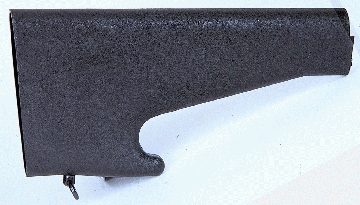
I just took delivery of 50 ounces of silver bullion from Northwest Territorial Mint.
NWT is a very reliable company, that produces a great many of the unit challenge coins for the US military. They even have an outlet store in the Pentagon. For bulk buying, they are usually one of the least expensive sources.
I ordered by phone in mid December. They advised me delivery would take 12-13 weeks at the time (in less hectic times, delivery is in days, not weeks), and read a standard disclaimer on bullion trading that should be familiar to all buyers. It's summarized here: https://bullion.nwtmint.com/buyingbullion.php#Terms
Their minimum order for silver is 50 ounces, and since I only cared about a reliable hallmark, I was able to get it at 99c over spot per ounce, including shipping, handling and insurance, for their Pan American brand. I ordered 50 one ounce bars. For that day, it came to $11.71 per ounce, which is a lot cheaper than the $15-$18 I heard reported as the "Real" price by some experts.
Payment must be made at once, and processing starts after the check clears. However, at any point, you may sell the bullion back and collect the difference (Assuming a price gain). Note that you still have to send the purchase check first before they'll send money back--this is not speculating and NWT is responsible enough not to run open debt.
They sent a purchase confirmation, first by email, then by USPS, dictating amount, price, terms and delivery condition, plus an account number and web access to tracking info.
Delivery was scheduled from when my check cleared in January, for 13-17 April. However, I got notice of shipping, and it arrived April 1st, in a very secure package, adult signature required. The fifty bars are packed in 10 bar thick mylar sleeves for ease of accounting.
NWT sells a variety of silver, gold, palladium and platinum bullion and coins. If you're local to them (Seattle area) you can pick up in person and buy smaller amounts. They ship worldwide, have account numbers for government agency purchase, and are very easy and professional to deal with.
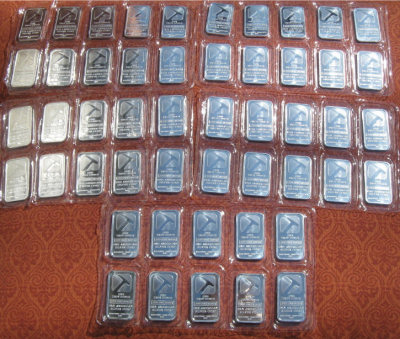
I recently tested the Ultramag .50, manufactured by Safety Harbor Firearms , Florida.
The Ultramag .50 is a bolt action, side-fed magazine, .50 BMG upper that uses the AR15 lower and trigger group. The two big advantages to this setup are that the Ultramag .50 requires no paperwork to purchase, and is not on record as a large caliber weapon, since it is bought strictly as "replacement parts." As far as anyone is concerned, you own an AR15, which can be more discreet if either purchased privately, or by using a forging such as this and drilling the 5 holes required to legally manufacture your own "single shot" lower (though the Ultramag is magazine fed).
The lower must not have a bolt catch, disconnector or buffer assembly. It only needs the hammer, trigger and fire selector. A magazine release is not needed, but I decided a flush fit 10 round magazine body filled with lead would help reduce recoil, though I have not tried this yet. I did equip the lower with a MagPul PRS adjustable stock in lieu of the factory stock.
Kit as tested included: 29" barrel with fluting, 5 round magazine upgrade from 3 round, an extra 5 round magazine, back up iron sights (BUIS) and carrying handle. I opted to use an adjustable Harris bipod, not the fixed length bipod from Safety Harbor, though this was for personal reasons. I'm sure the bipod is quite sturdy. SHF includes a heavier hammer and spring and an anti-walk hammer pin with the kit. List price for this kit is $2595. It's possible to save quite a bit with less options. While they do offer 18" and 22" barrels, those have always seemed too short for .50 BMG to me, since it was designed originally for a 36-40" barrel. They told me delivery would be 8-10 weeks, and it arrived right at 9 weeks, in a professionally fitted cardboard box within a box, instructions for changing the trigger group, a contact number for support and a catalog for accessories.
Fit, finish and operation of the Ultramag .50 can be described as flawless. One of the magazines had a very minor ding, possibly from shipping, that made it a bit sticky. SHF said to send it back and they'd replace it at once, no questions asked.
I mounted a Smith & Wesson 4-12 X 40 scope on the integral rail. This was previously on a different rifle and rail, and my first shots were about 12" low at 100 yards. Shooting was very consistent, and once I got zeroed the bullets went EXACTLY where the crosshairs were, every time. This was only a warm up, and I didn't get to shoot to any longer ranges to do a full shooting report. One of the disadvantages of flat Eastern states is finding a range that will allow a weapon this powerful. I have to drive almost 2 hours to reach one.
Recoil with the 8 chambered muzzle brake is comparable to a 12 gauge shotgun. I do recommend a recoil pad and a good shoulder seat with the stock. Seating it a little high can sting. I recommend Loctite for the scope mount-every two rounds was enough to loosen the mounting screws to where the mount would wobble. This is a problem with the scope rings, which were not part of the Ultramag kit.
The .50 BMG round holds the record for sniping at 2430 meters, and at ranges not much less can easily disable an engine or other heavy equipment. At $3.50-$7 per round and 20+ pounds, it's certainly not a close in or primary survival weapon. However, for defending the approach to a remote retreat it's just about the most accurate and powerful round available to civilians in the US.


My new acquisition is the OLight T20M 5W. I wanted something as bright as my Surefire, but to be able to dial it down when I didn't need quite that much light. The OLight T20 is even brighter than the Surefire when set at max, 210 lumens, with four times the battery life with the same C123s (90 minutes vs 20 for the 120 lumen Surefires), 70 hours at 10 lumens, and has a memory function so it recalls the last set brightness. The electronics keep brightness high until the batteries are depleted.
In addition, it has a strobe function that can make it a devastating defense weapon. I tried it on myself, and the strobing 210 lumens completely disoriented me, even in indoor light, and left me dazzled for about two minutes. It would make a great addition to any hand to hand encounter with a bad guy. The price is reasonable, and includes a lanyard, a snug, well-crafted holster and spare gaskets for the switch.
This is my second OLight. One of their greatest bonuses is that they accept user feedback and incorporate upgrades into each new model. The downside is you have to keep buying new lights. However, I feel it's worth having a good tactical light in each vehicle, room, and on your person for emergency use.
My preferred source for lights is Flashlight Outlet. Larry really knows the subject and provides exceptional customer service.
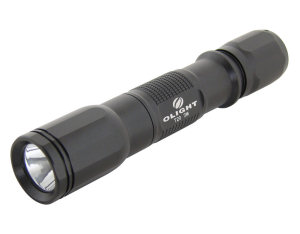
Top | Firearms | Preparedness Gear | Supplies | Training & Reference